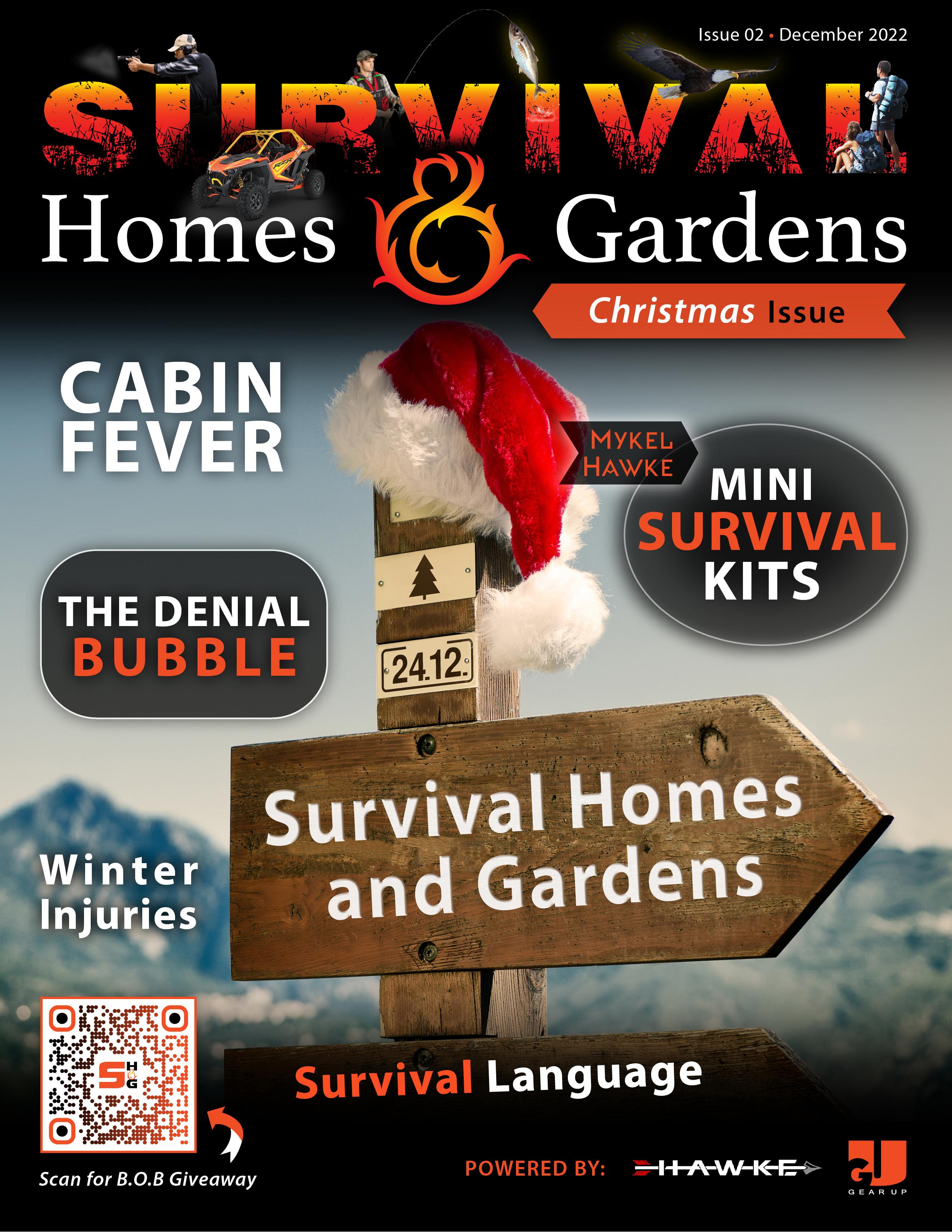

LIMITED COPYRIGHT
Materials, written, graphic, or otherwise that are contained within the SH&G magazine are protected by copyright law. No part of written text or graphics in this magazine may be reproduced or transmitted in any form or by any means including electronic or mechanical or otherwise, including by photocopying, recording, fax transmission, or using any storage and retrieval systems without the permission of SH&G. No content in this magazine may be distributed for any commercial purpose whatsoever.


Any and all trademarks carried within the Survival Homes and Gardens magazine are the property of their respective owners.
© Copyright 2022 Survival Homes and Gardens. All Rights Reserved. Magazine and Website Disclaimer located in Website Disclaimer.
MORE INFORMATION
Gear Up Outdoors LLC Mykel
LLC
SALES
MAGAZINE
PUBLISHERS
Hawke
EDITOR-IN-CHIEF John Dowd CREATIVE DIRECTOR WEBMASTER Ignacio Guerrero
MANAGER HK Holland SH&G
TRADEMARKS 9318 N. 95th Way Suite A109 Scottsdale, AZ 85258 Phone: (480) 707-7107 survivalhomesandgardens.com info@survivalhomesandgardens.com
EXPERT CONTRIBUTORS
HAKIM ISLER
(aka The Black MacGyver) is the nation’s premier, professional African-American survival expert. He is most notably recognized for his appearances on Discovery Channel’s Naked & Afraid, Naked & AfraId XL and FOX’s Kicking & Screaming. A man of many skills, Hakim is a decorated combat war veteran, Ninja fifth degree black belt, certified close-protection specialist and professional self-defense & combat weapons instructor. A business owner, published author, motivational speaker, TV host/ personality and inventor – holding several patents and trademarks – Hakim is constantly pushing the limits of achievement.

RAYMOND MHOR
Raymond Mhor is The Kilted Prepper. He is an author, blogger, and internet influencer who has been in the survival arena for over 20 years. Ray has eight books, multiple television appearances, and many radio/ podcast interviews to his credit.

Ray’s motto is ...“Real Prepping for Real People –None of the Hollywood Stuff.”

He currently lives in the Blue Ridge Mountains of Virginia with his wife Cynthia, their daughter and their three dogs. The Mhor family enjoys the homesteading and preparedness lifestyle.
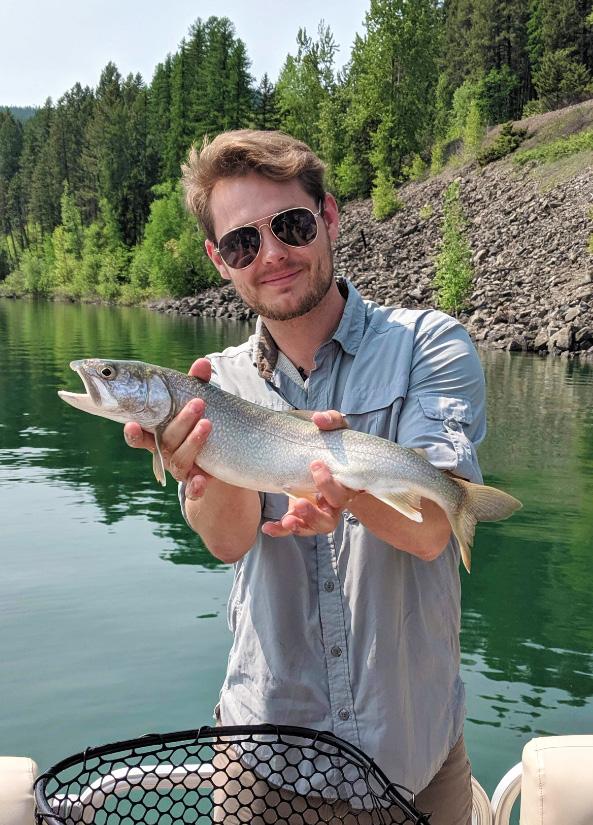
EDITOR’S NOTE
 author, the books,
author, the books,


Statistically, the United States ranks second in countries with the most natural disasters, according to statista.com. According to fbi.gov, recently there was a 4.1% rise in violent crime in the U.S. totaling over $1.2 million. There is also the continued looming and growing threat of domestic terrorism that must be considered. According to an article by the Washington Post, “a Federal Emergency Management Agency (FEMA) survey found that nearly 60 percent of American adults have not practiced what to do in a disaster by participating in a disaster drill or preparedness exercise at work, school, or home in the past year. Further, only 39 percent of respondents have developed an emergency plan and discussed it with their household. This is despite the fact that 80 percent of Americans live in counties that have been hit with a weather-related disaster since 2007.” Even with all these facts, it seems that to most Americans still don’t pay attention. FEMA highlights that people still choose to be oblivious, nonchalant or just plain irrational about the importance of preparedness, even on a small scale and although faced with real facts and life altering disasters that have touch us, friends or family members. In my research, I have found names for this behavior like “Normalcy Bias,” which is explained as a way for the brain to deal with a traumatic experience by leading us to believe all is okay or believing that bad things will never happen to us.
A much more common, longer used and more direct name for this type of behavior is, “Denial.” According to Sigmund Freud, a 19th century neurologist, denial is classified as a defense mechanism. He categorizes denial in 3 main categories.
1. Simple Denial – This is when someone is in denial that something unpleasant is happening

2. Minimization – This is when someone admits an unpleasant fact but denies its seriousness
3. Projection – This is when someone admits an unpleasant fact and the seriousness of it but chooses to not take responsibility for it or blames someone else for it.
First, simple denial. Often, when we hear about traumatic or stressful situations, we hear the phrase from the people who lived through them: “I couldn’t believe this was happening to me.” Sure, if you are like me you, have thought to yourself “well, why could you not believe it was happening? Bad things happen to good people all the time?” I believe that which has happened in our society is that people’s lives have become so busy, disconnected and full of alternative options that it becomes more and more easy to consciously and subconsciously avoid negative experiences. Slowly, our lives become one sided allowing us to experience only the things we feel are pleasant. When we feel something may be unpleasant, we avoid it or remove ourselves from it. This creates the illusion that we are safe from the things that we don’t want to happen. The illusion that somehow we are in complete control of our total experiences in the world.
However, when the unavoidable truth of something bad happening interrupts our lives, we can’t believe it is happening because it is not something we chose to happen. An easy example of this is something we do at our martial arts seminars.
We sometimes use aggressive language with people who normally don’t deal with this in their life. The result is that people freeze, or they need a break because they simply aren’t used to the projection of energy given off by aggressive language. People just cannot believe that it is real when something like this happens because it is not their normal reality. So, they deny it and usually that means they don’t act. This happens in survival and disaster preparation as well. People are so far removed from the idea that they will not have water or power that they choose not to prepare. This is because it is not a real threat to them, since they have never allowed themselves to be in a situation like this, which leads to not believing a situation like this is possible.
Second is minimization. My first overwhelming experiences with this were in the Army. From everything to jumping out of planes, to getting an ankle twisted very badly while on a night land navigation course. In order to keep up with the group, a soldier would often minimize his or her injuries. “Yeah, I hit the ground really hard and landed on my hip weird; it hurts but I’m okay,” as they are barely able to walk away. When it comes to disaster this happens when people repress situations they, or their families, lived through. You will know what I’m talking about if either you, or someone you know, lost everything in a flood or lost heat and power during a storm. Immediately after you suffered through it you probably told everyone how horrible it was and how you, or the person you know, was on the precipice of not making it, but then help came or things were restored. The difficulty is made clear, yet after a few months have passed it just becomes a cool story. One that after each time you tell it, the power of the experience becomes more a fairytale and distant, than a real event that lasts in a way that invokes action to minimize it from ever happening again.
The survivor who uses the minimization type of denial when telling stories about distressing situations in the past make statements such as, “yeah that was a little scary, but I was fine.” However, the people who talked to them after the event heard a very different story which normally sounds way more dramatic and dyer.
Repression is tempting because few want to remember their hardships, especially hardships that were made significantly worse based on their lack of action and preparation. It then becomes a cycle because, instead of acknowledging this fact using it to act, they avoid the truth as a way to not have to acknowledge their failures.
Thirdly is projection. It has happened so many times that it has become like a bad joke. A storm is reported to be moving towards an area and the people are warned to leave that area. However, instead of leaving the area the people choose to stay. Segments on the news show locals stating, “I don’t think it will be that bad,” or “I’ll just ride it out.” Then the storm comes, and those areas are decimated and some of those same people end up on the news complaining about

9
Photo by Ractapopulous
how long it took for rescue to come or how little help they are getting when it comes to medical care, food and shelter. Those of us watching feel bad for them but often wonder why they didn’t leave when the warnings went out, or at least prepare. The answer is summed up in a word, but it is not simple at all. The reason some of these people chose to not follow the advice of officials is called “projection.” Projection, as mentioned earlier, is a state of denial where someone acknowledges the seriousness of a situation but refuses to take action or responsibility. Common aspects of how projection can manifest are as follows:
• People can, and will, procrastinate because it is not immediate. A simple way to see this in action is to look at the field of investing. A study done by Northwestern Mutual showed that 58% of American’s feel their financial efforts need improvement and 34% have done nothing to plan for their financial future. We live in such a here and now environment that the idea of seriously planning for something that will happen in the future is not something we feel we prioritize or take action on.
• People will sometimes not take action because the task or outcome is so big that they have a hard time imagining an outcome and thus a solution. Without actually living through a disaster, it is tough to understand the level of devastation one could cause in your town. Sometimes the thoughts of this type of thing can initiate procrastination or rationalization. People will often push the responsibility off to a perceived authority. I have
read statements where people say stuff like “that’s why I pay taxes, so emergency responders can be equipped to help in a disaster.” I have also heard people submit to the concept that “I would just die.” It is understandable that if it is out of a person’s scope of life, it becomes tough to imagine a solution or outcome. However, this excuse was much more applicable before streaming news and the internet. Now, it is too easy to see and learn about the effects of natural disasters. This takes a lot of the guess work out of it. Disasters are still a big deal, but seeing their effects gives a reality-based example that can be used to determine response to a possible threat in a person’s area.
• Often a response to an issue can be tempered by social acceptance by people who’s opinions we value. If a friend or neighbor feels like it is not an issue, we may not believe it is an issue. People follow other’s behaviors. If a person is unsure of what to buy at the grocery store for survival during a pending disaster, then when they see people buying milk and bread, that’s what they buy. In my hometown of Fayetteville NC, I am always surprised at how the milk and bread shelf goes empty during a severe storm warning. People don’t take into account that perishable items are not good choices as they spoil quickly, especially things that should be refrigerated. They also put too much energy towards things with low nutritional value. There are better choices, but they are not commonly known and thus people will see someone else buying something and decide that is what they will buy.

There are some Simple Solutions. People will argue many points about why they aren’t prepared and as I’ve shown earlier in this article, it can often just be denial. Let me first state that it is okay to be skeptical about what could and will happen, but to flat out deny things that are happening and that have happened is where things become unhealthy and dangerous. You don’t have to become a disaster guru or a doomsday prepper to be prepared for a natural disaster. All you need is a slight change in mindset and small actions that will lead to big results if something does happen. Below I list four small things you can do to help defend yourself against this unhealthy “disaster denial” and to prepare for a possible storm:
 Photo by Polina Zimmerman
Photo by Polina Zimmerman
1. First just accept that it is a good idea to have some bare essentials around the house, just in case you need them. Having some extra bottles of water and first aid essentials can’t hurt. If you live in a cold climate, having a way to stay warm without electricity is never a bad idea either. You can normally go three weeks without food, so for most Americans who suffer a disaster, they will be able to get food within this time. However, if you have a baby you may want to have some extra food around.
2. Second, accept the fact that disasters are real and can and will happen in your area. Turn on the news and you will see disasters happening everywhere. It may not be today or tomorrow, but they will happen close to you at some point. If you can accept this truth, it will make facing the shock of a disaster a lot easier to overcome and thus improve your response time.
3. Thirdly, find out what disasters have happened in your area. They may not have happened recently, but most areas have had, or are susceptible to, some sort of disaster. Unlike 25 years ago when you would possibly have to go to a library to figure this out, now the answer is one Google search away. Once you have your answer, come up with some small preparations to help your situation during an event like this. If you are unsure, take another minute or so and do a Google search for this as well.
4. Fourth, don’t allow yourself to get overwhelmed or burnt out. The only time things get really serious is when the storm is upon you. Think of training to be fit or studying for a degree. None of this happens overnight. This is a marathon not a sprint. Gradually get to a point where you feel comfortable. If not, you will burn out and end up further away from success. I have read that most people fail to follow through with stopping bad habits because they change to drastically, too soon, and they also fail to replace bad habits with good ones. People who follow these guidelines tend to have more success than people who don’t. Instead of trying to become a full-on disaster prepper tomorrow and wiping out your bank account to buy a bunker in the hills and stock it with food and ammo, start simple. Take a cheap two-hour self-defense class every few months and
buy an extra case of water once every month. Once you have six cases, or whatever number you choose, start the process of drinking the oldest case and replacing it with a new one. Follow this same process with canned foods. Take a one-day survival class with your parks and recreation group, especially if you are not an outdoor-person, this way you don’t have to campout and you are not too far from home. Buy a pack of lighters and candles once every year. Soon, you will find that you will start to build a strong emergency kit and it was a smooth and painless process.
As we become more technologically advanced and wrapped into our digital reality, our physical reality becomes much less pressing. We don’t experience danger the same way or fear the same way. We are quick to remove ourselves from environments we don’t enjoy or that make us uncomfortable. Our new belief is that real is only what we want real to be, and facts are only what we choose to believe. Unfortunately, when life and nature show us the contrary, we find ourselves grossly underprepared and at a loss. Not because we were not warned, but because we chose not to act and to deny the reality of nature. Unlike our ancestors who focused heavily on nature to survive, modern people lack the need to listen to what nature has to say. This is due to the artificial environment that we have created, which allows us to hide from the voice of nature until she throws a disaster tantrum that can’t be ignored. It is then that we recognize our mistake; when it is too late. So, I ask you, “what are you going to do with this knowledge? Will you shrug this off as a good read, or will you plan for a brighter future in your darkest moment by taking some small steps to prepare yourself for what could come?” Today is the day you no longer deny it, but you defy it! Be as ready as you are comfortable with; just start your preparation!

Three weeks without food, three days without water, three seconds without hope. Under extreme conditions this is how long humans can survive without these essential components. Hope is a mindset and arguably one of the most precious survival resources available. It can be defined as a combination of optimism and realism and may best be understood by way of the “Stockdale Paradox.”
The name refers to Admiral Jim Stockdale, who was the highest-ranking United States military officer in the “Hanoi Hilton” during the Vietnam War. During his eight-year imprisonment from 1965 to 1973, Stockdale was tortured, starved, stripped of his rights, had no set release date, and no certainty as to whether he would survive to see his family again. When asked in an interview, “who were the ones who didn’t make it?” His response was, “The optimists.” Hope doesn’t replace preparation and hard work. Relying on false hope and the utilization of denial as a coping strategy is dangerous. Through his experience, Stockdale determined that a survivor “must maintain unwavering faith that you can and will prevail in the end, regardless of the difficulties, and at the same time, have the discipline to confront the most brutal facts of your current reality, whatever they might be” as written in Jim Collins’ bestselling book, Good to Great.
A survivor is adaptable and resilient. They possess a keen ability to see the big picture while focusing on small and obtainable goals towards progress; refusing to be discouraged by setbacks. A survivor will do whatever necessary to overcome any challenge; they don’t know quit. Simultaneously, a survivor is acutely aware of the reality they face, if they are lost, they recognize and accept that they

are lost. If they are injured, they accept that they are injured. Acceptance of reality prompts action necessary for survival.
Maintaining hope in a survival situation can quite literally be the difference between life and death. “Give-up-itis” is a term that was coined by medical officers during the Korean War. They described it as a condition where a person develops extreme apathy, gives up hope, relinquishes the will to live and dies, despite the lack of an obvious physical cause. This concept is described in more detail in the article Give-up-itis: when people just give up and die by John Leach, a Visiting Senior Research Fellow at the University of Portsmouth. The medical officers witnessed some of the prisoners within just a few weeks, begin to refuse food and become mute and unresponsive before they “turned their faces to the wall” and died. The result of losing hope or surrendering to give-upitis is psychogenic death or, in other words, literally thinking oneself to death. Our minds have profound capabilities to control our bodies, understanding the mind-body connection and our instinctual stress responses is one of the best ways to prepare for and increase chances of survival.
When humans experience stress or encounter danger, our sympathetic nervous system, or what I call our primitive brain, takes control. The amygdala is considered the center of the brains defense system. As advanced as us humans feel we are, when it comes down to it, we are just animals. When we sense danger, our response is primal. In a survival situation the amygdala signals our body to prepare for fight, flight, or freeze. In doing so, physiological
and hormonal changes happen involuntarily. Our blood pressure and heart rate increase to supply more oxygen to our major muscle groups, pain perception lowers, hearing sharpens and vision narrows by almost 70%, according to Psychology of Survival by Robert B. Kauffman.
Cortisol released from the adrenal gland interferes with the capacity for complex reasoning and problem solving. These changes make us intensely aware of danger while inhibiting the mind from taking the time to access long term memory. This makes it possible to react in an instant. This is one reason why practicing a skill until it becomes muscle memory can be hugely beneficial in stressful situations. This primal response to stress is key to survival, however, after a traumatic incident or under situations of consistent stress, the bodies nervous system can get stuck in panic mode or in a chronic state of fight or flight. If stuck in this state, the survivor will have a more difficult time with problem solving and the use of logic and reasoning, making it difficult to maintain a positive mental attitude, plan, prepare and take action. One way to combat this is to strengthen the parasympathetic nervous system.
The parasympathetic nervous system is the opposite of the sympathetic nervous system. It is designed to calm the body down after a stressful situation or remain calm when faced with danger. The Vagus Nerve is the longest cranial nerve found only in mammals. It connects the brain stem to the rest of the body. A healthy Vagus Nerve means calmer responses to stress and increased resilience. As stated above, a survivor’s ability to pull through trauma and bounce back from failure or disappointment is critical. It doesn’t take the biggest, strongest, or most skilled survivor to overcome the most extreme and dire circumstances, it takes true grit and the mastery of psychological strength.
Outlined here are some suggestions to help strengthen the survival mindset and increase resilience and mental fortitude. These are tools that will not only help you in your everyday life, but, in the case of an extreme emergency or survival situation, could determine the outcome for better or worse.
Preparation - Knowledge of the environments, terrain, natural resources, threats, shelter building, fire craft,
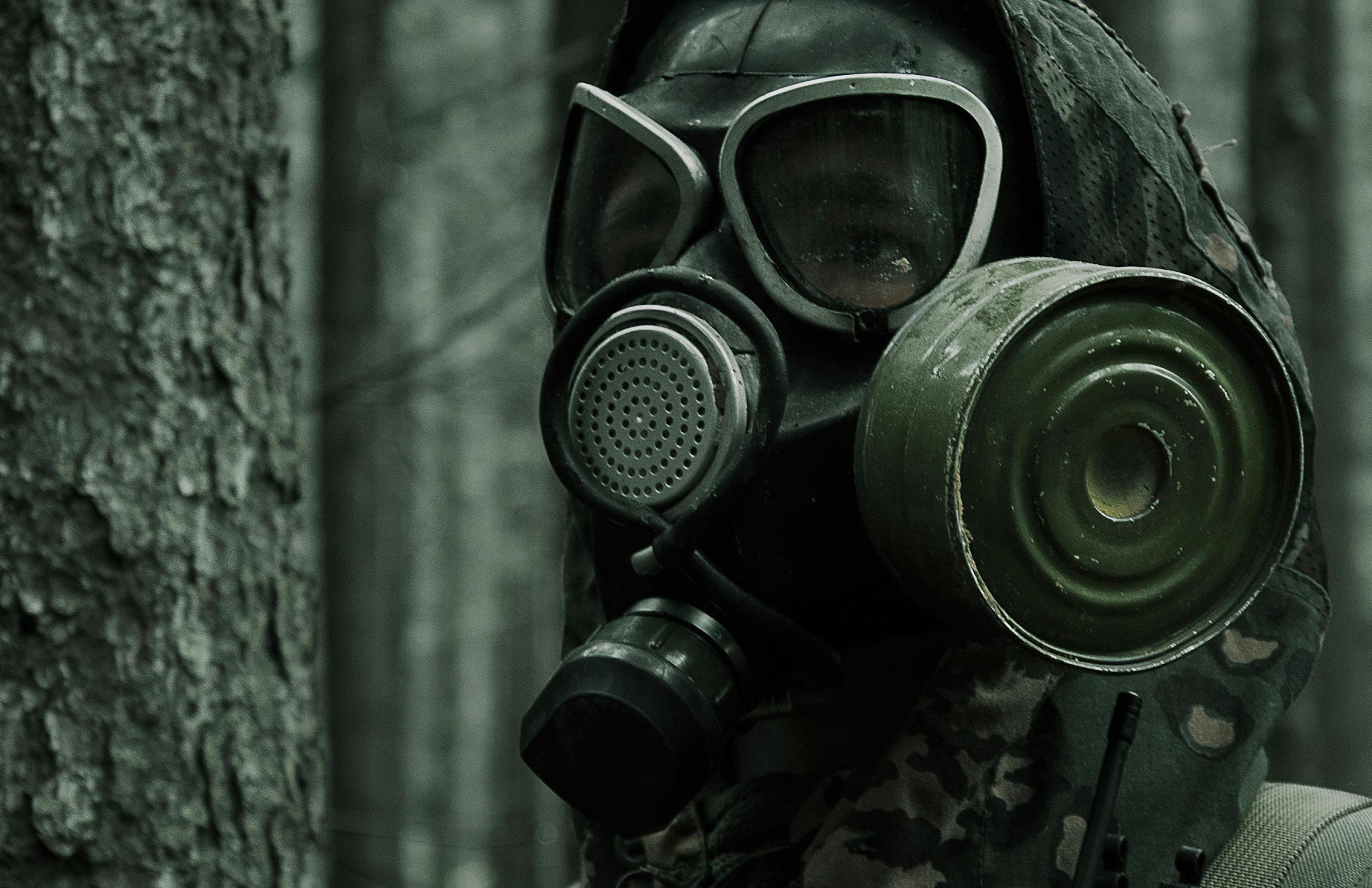 Photo by Tntk
Photo by Tntk
food and water procurement, etc. are all extremely beneficial skills for a survivor’s toolkit. Practicing the skills to muscle memory will assist the survivor in responding appropriately when the fight/flight response is engaged. Remember, knowledge is beneficial, but application is best. Continuously find ways to challenge your skills and mindset. Pursue activities in your daily life that push you outside of your comfort zone and present the risk of failure. The goal is to experience failure, disappointment and stress as often as possible in a safe and controlled environment. Exposure training in therapy is a leading intervention in overcoming anxiety and phobias, guiding individuals on how to better control their stress response. In military SERE (Survival, Evasion, Resistance and Escape) programs, students are exposed to the discomforts of wilderness survival, simulated capture and resistance, simulated downed aircrafts and under water egress. These scenarios are designed to test their knowledge, apply their skills and train their brains to respond appropriately to intense and dangerous situations. Virtual exposure therapy is being utilized by the Navy Seals to train for combat in studies for prevention of post-traumatic stress disorder. All of this training is designed to prepare and strengthen the survival mindset and increase one’s ability to bounce back quickly. There are other opportunities to help manage and strengthen the
stress response is through meditation, yoga and martial arts. All of these activities help one practice mindfulness of the mind-body connection, strengthen the Vagus Nerve and develop the skills to regulate the nervous system and increase resilience from trauma/stress.
Planning - Develop courses of action and determine what you need in order to execute them. Supplies, currency, logistics, medical, communication etc. Be constantly conscious of what could go wrong and whether you are prepared to handle it appropriately. Have a plan as well as a contingency plan. When the situation changes, have a well thought out strategy of where to go, how to meet needs, mentally cope and more. Remember, it is better to have a plan and not need it, then need a plan and not have it. Keep your head on a swivel, pay attention to detail and continue to assess danger and plan accordingly. The benefits of planning are that it provides the survivor with direction, confidence, stability and reinforces the positive mental attitude and the will to survive.
Execution - When you experience conflict or disappointment in everyday life, how high does your stress meter get? If you find yourself losing your cool often, staying upset, or ruminating on the negative, you may not do as well in a survival situation as you
 Photo by Bethany Bowater
Photo by Bethany Bowater
might think. When failures, setbacks, or disappointing events happen, I encourage you to notice what is happening with regard to that mindbody connection. First, do a body scan. Start from the top of your head and notice everything that is happening within your body. Is your face hot/ flushed? Is your jaw tight? Is your heart beating faster? Is your stomach in a knot? What is happening to your body temperature, knees, fingers and toes? Pausing and practicing this mindfulness technique will begin to calm the nervous system down. Another way to strengthen your Vagus Nerve is through diaphragmatic breathing exercises.
Here is an example of how to engage in a diaphragmatic breathing, from an article by Theodora Blanchfield, AMFT, a marriage and family therapist trainee as well as a mental health writer.
How to do diaphragmatic breathing (deep breathing)
1. Begin with one hand over the heart and one hand over the belly.
2. Breathe in through your nose and let the air fill your belly. Keep your hands on your heart and belly and observe how the one on your belly moves while the one on your heart should stay the same.
3. Draw your navel in towards your spine as you exhale as if you were blowing out birthday candles.
4. Feel as the hand on your belly slides down to its original position.
5. Repeat this three to five times to start, noting how you feel after each time.
Next do a mind scan. What is your self-talk like? Do you speak to yourself with compassion, understanding and encouragement or do you call yourself names and have self-defeating thoughts? Many people struggle with cognitive distortions, or thoughts that are extremely unhelpful and selfdeprecating. Here is a list of just a few:
Polarized thinking: “All or nothing” or black and white thinking patterns, inability to acknowledge that two things can be true at once.
Overgeneralization: Focusing on a negative event and making conclusions based on that single piece of negative evidence.
Catastrophizing: When a thought is over-exaggerated or diminished. Instantly believing the worst-case scenario will happen with little evidence to support the thought. Or minimization of the positives.
Control Fallacies: Control fallacies can go two ways. An individual either feels responsible for everything and holds all the control or blame when things don’t go right, or the individual believes they have no control over anything that occurs in their life.
Heaven’s Reward Fallacy: The belief that good things will happen to good people or that one will be rewarded based on how hard they work. This cognitive distortion will leave its believers constantly disappointed, frustrated and even resentful.
How many of these cognitive distortions do you fall prey to in everyday life? Our thoughts have an impact on our behaviors as well as our feelings and mood. The moment negative thoughts, self-doubt, or cognitive distortions enter your mind it is important to quickly reverse it into a more adaptive and helpful thought. For example, change “I won’t ever get this fire started” to “I didn’t get this fire started this time, let me come back to it and try again.” Assess how well you handled that stressful situation and decide how you can adapt and do better next time.
Adaptation - Constantly analyzing and monitoring your reactions and making necessary changes to be more successful. Heighten your awareness of how you respond to stress. Maybe log it in a journal. Take note of what happens in your body and practice different techniques to find which ones works best for you. Reassess early and often during your preparation, planning and execution to see where you need to improve and then tackle it.
Understanding the psychology of survival and developing a stout survival mindset is an invaluable resource for anyone who finds themselves in an extreme or dangerous situation. It has been consistently proven that no matter the size, age, physical strength or skillset a person possesses, if the individual loses hope and the will to survive, their chances diminish greatly. The human mind is profound in its ability push through and overcome the most austere circumstances. The body’s natural defense system is nothing short of a real-life superpower. Understanding the mind/body connection and working to become a psychological juggernaut takes practice and consistency. The tools and techniques discussed within this article to develop a healthy nervous system will increase resiliency and improve the overall mental health of those who practice them. Whether we find ourselves in the elements, battling mother nature or surviving a world that is growing more uncertain every day, a survivor will never discount the importance of mental fortitude and developing the survival mindset in all that they do.
15


- Travel Safer, Travel Smarter
Mini Survival Kits
Here are some ideas for what to consider packing:
FOOD- Jerky, Power Bars, MRE’s, Vitamins, Dried Foods
WATER- A durable bottle, Purification Tablets, Mechanical filters

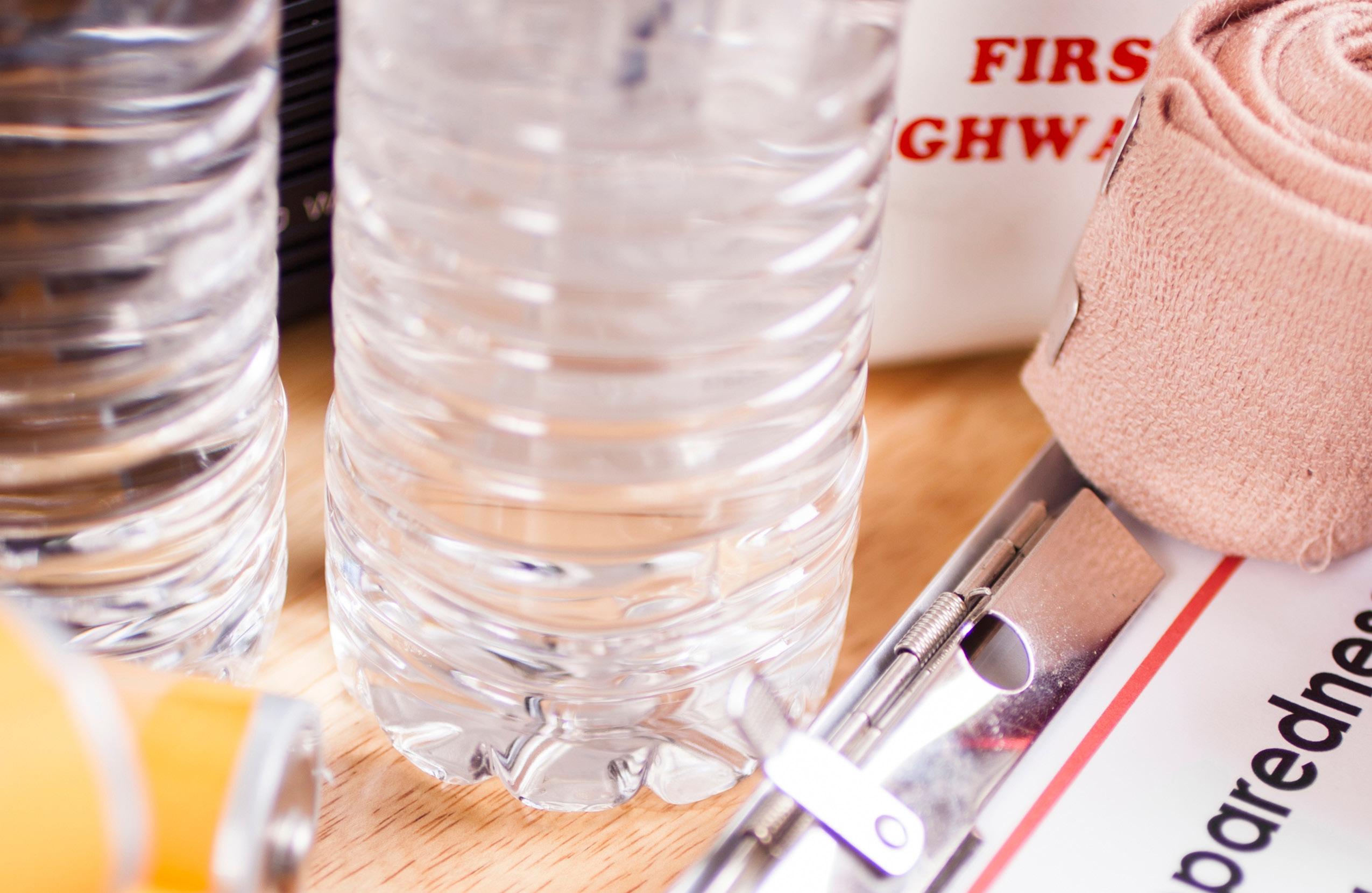
FIRE- Lighter, Matches, Tinder, Fire starters, Mag Bar, Ferro Rod

SHELTER- Tiny Tent, Bivvy Sac, Large Trash bag, Space Blanket
NAVIGATION- GPS, Spot, Beacon Transponder, Map, Compass
COMMUNICATION- Phone, Radio, Mirror, Whistle, Flashlight
SECURITY- Knife, Gun, Tools, Alarms, Trip String, Pepper Spray
MEDICINE- Dressings for Trauma & Medications for Illnesses
Photos by Mykel Hawke

by Fstop123
Photo
Lastly, it is important to note that a medical kit is another form of survival kit and as such, I recommend making one of each. For all of these, you will also need to consider your skills and your situation. It is usually thought that the more you know, the less you need, and generally that holds true. However, even a pro like myself likes to have what I need when I need it, so I always have my two kits: survival and medical. I will have these in three layers: personal (on me), mobile (in my transport), and stationary (my main base or regular destination). Each reflects in size and content what I need to take care of myself and my loved ones in any exigency.

I have made many kits over the years, for FEMA, the State Department, Combat Search and Rescue as well as for friends and family. These are fun projects to take on and share with loved ones. Take some time to research your needs and make what you need, but also, play with them, use them and refresh them annually.
For more information on kits, readers can go to www.mykelhawke.com.
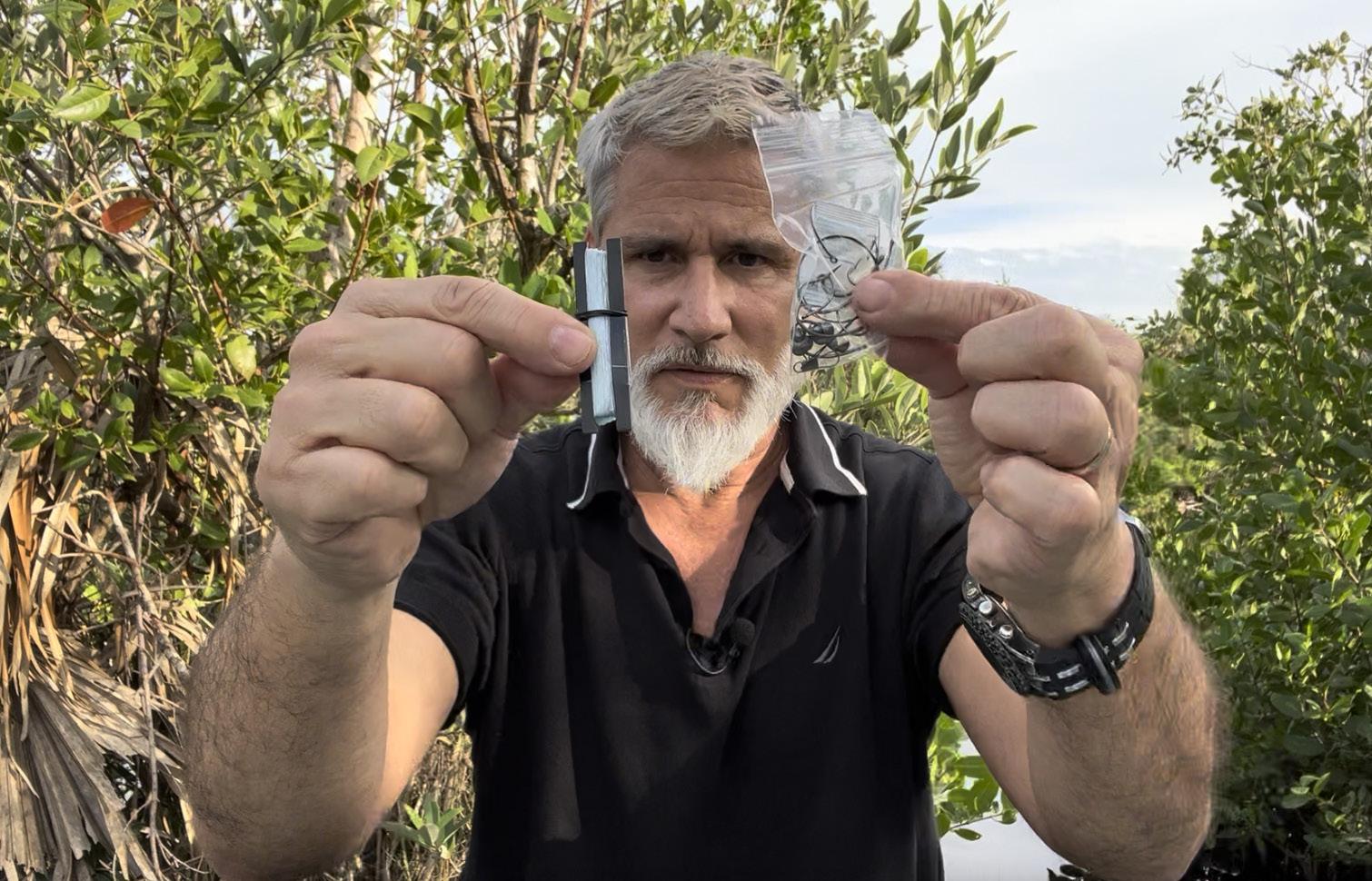
20
Photo by Mykel Hawke
Photo by CatLane
Maps give a display of the land, with representations of direction, altitude, landscape, and landmarks. The only problem with maps is that they are very little help in travel when one does not know where he or she is on it. Using some deduction and a vantage point, one can surmise their position on a map in the wild. The use of landmarks, combined with pictorials displayed on maps, can give an idea of position, and then direction.
Common sense can play a huge role. For example, if one knows they are lost somewhere near a river, then if the map shows a river to the west, one can conclude (knowing where the river is from one’s own location and on what general side of it one is on based on direction of flow, location of other land marks, etc.) that if they face the direction of the river from their position, then north is to their right. If on the other side of that river is civilization, then that is the direction to travel.
There are several types of maps one could encounter in a survival situation, depending on the location. The most useful of these include sea navigation charts and topographic maps. All maps and chats have a few simple components. The legend, which is a box at one of the corners of a map that will display symbols and their meanings, is a big part of understanding a map. This will tell the user of things like buildings, streams, railroad tracks, landmarks, and more. There is also the face, where the title and
often the map’s scale can be found.
On many maps, including navigational charts, there are vertical and horizontal lines that run north/ south and east/west. These lines help determine exact position on a map, chart, or GPS. The horizontal lines (left to right, east/west) are the latitude lines. The vertical lines (up to down, north/south) are the longitude lines. Lines of latitude describe how far north or south one is from the equator (the middle line of the earth, where the earth rotates around the sun). Longitudinal lines describe how far east and west one is from the prime meridian (an invisible line drawn around the globe cutting it vertically between the poles; the opposite cut from the equator, both of which together cut the earth into four parts). These two measurements will appear on a map with the latitude written out first, and work like a grid on the surface of the earth. For example, and object is sitting at 50°N, 69°W. This means that the object being located is 50 degrees north of the equator, and almost 70 degrees to the west of the prime meridian. It begins to get more complicated, as not all things fall in those spaces. These degrees are then further boiled down into minutes and seconds (easy to remember, as there 60 minutes in a degree and 60 seconds in a minute). This means that most GPS coordinates will look something more like: 10°24’12.5”N, 70°14’15.2”W. What this basically translates into is 10 degrees, 24 minutes, and 12.5 seconds north of the equator and 70 degrees, 14 minutes, and 15.5 seconds west of the prime

meridian. For the curious, this is a random location in a northern Venezuelan mountain range.
Navigation charts will display land masses, sea depths, and even tides. There are a lot of other bits of information that can be displayed, however, for the quick and dirty reading of a navigation chart, those three things are the most important. There can be contour lines that determine depth, but there will also be a series of numeral values all over the chart. These numbers explain the depth measurements, or soundings, of the water in various places. The chart user must read the map face to learn the scale and the measurement for the number’s meanings. This will often be in large print and will read something like: SOUNDINGS IN FATHOMS AND FEET. Most charts today in the U.S. today are measured with soundings in meters, but charts made before the early 1990s were mostly in fathoms and feet. Generally, they are a two-digit code, with the first number in fathoms and the second in feet. For example, one may see a sounding of 64. This would be six fathoms and four feet (fathoms are equivalent to about six feet). If the chart is in meters, then a meter can be divided by 0.3 to find the depth in feet. On navigation charts, tides
and their directions can often be displayed by arrows.
Finding position on a navigational chart can be far more difficult than on a topographic map. On the later, one must only triangulate their position with two or three landmarks on the map, such as a mountain and a lake. This may not bring an exact set of coordinates, but it will allow a survivor to generally use a map and find his or her way around an area. On the ocean, with no reference for position but the stars at night, navigation becomes extremely challenging. The simplest way, without tools, is to find one’s latitude. This is done by determining how far the north celestial pole (the north star) is above the horizon. Traditionally, this was done by looking through a tool known as a sextant. Since it is unlikely that a survivor is carrying one of these around, the human arm will work in a pinch. To find latitude, one must outstretch his or her fists and place them one after the other, stacking between the north celestial pole (north star) and the horizon. Each fist length measures about ten degrees of latitude from the equator. This same trick can be done on the southern hemisphere by finding the southern celestial pole
 Photo by Richellgen
Photo by Richellgen
(finding both celestial poles is described later in the section Using the stars). Longitude is far harder to determine accurately using only the stars.
The topographic map is like a navigation chart, but on land. These maps will display things like water sources, topography (hence the name), and prominent landmarks. The most obvious features on this type of map are the contour lines that snake about the surface. These will run mostly parallel with other lines and will display altitude. The basic idea is, the further the lines are apart from each other, the more gradual the rise in elevation, and vice versa. This means, that if there is a collection of lines very close together, one can rightly assume a steeper pitch. Displayed along these lines will be numbers that can mean measurements of either feet or meters (most U.S. topo maps are in measurements of feet above sea level). Again, like the navigational charts, the map face or legend will explain. Towns or high points can usually be found displayed on these maps as well.
Finding direction is generally, the easiest piece of information one can acquire. Usually, direction is

defined by the four cardinal directions, north, south, east, and west. North points towards the north pole (top of the globe/ earth) and south to the south pole (bottom of the globe/earth), relatively. East and west refer to the directions around the planet. If one is looking directly north from their position, then east is the direction immediately to the right of that person and west is immediately to his or her left. There are different types of north, such as true north and magnetic north, however, in survival these details do not matter. Finding any north will work with a map well enough for a survivor’s purposes.
The compass is one of the most universal tools for orientation. A compass will determine magnetic north, as the red arrow on the compass will be drawn northward, and its opposite pole towards the south. If one does not possess a compass, there are ways to make one expediently. The best way is to collect a metal needle, a magnet, a small piece of buoyant material, and a small container for water. First, one should take the magnet and run it up the needle rapidly. This should be done in one direction, preferably towards the point, and as many as a dozen times. This will temporarily, and mildly, magnetically
Photo by Joshua Woroniecki
charge the needle. Next, the person should take the needle and poke it through a cork, piece of wood, or anything small that will float in water. The needle should be pierced all the way through the material, with the eye side and point side both sticking evenly out of the object, balancing on the center of the floating material. Next, a bottle cap, bowl, or shell must be filled with liquid. The floating needle can then be placed into the water and let to rest. After a few minutes, the needle should come to rest pointing north. It may help to spin the needle to loosen it up and get it to rest properly. If this is done, it must be done several times in order to confirm a correct reading. Taking the magnet near the new compass and spinning it around should draw the north end of the needle towards the magnet. This will check which end points where.
To use the compass and a map in conjunction, the basic simplified technique is as follows: The first task to using both is to “set the map.” This involves getting the map to orient north and match the environment. The map should be laid as flat as

possible, and the compass set anywhere on it. An orienteering compass works the best. Next, the map and compass must be rotated until the needle pointing north lines up with the north-south lines on the map, lining everything up with north. This should be done in an environment with easily seen natural features which can help establish location on the map. If the survivor takes the map to a high point, he or she can triangulate, as mentioned before, his or her location. Once a single feature is identified on both a map and in reality, they can begin to work out their position that way. This process would start with the survivor making their way to that point, as they would then know at least they are somewhere relative to that feature.
If a person has that orienteering compass, this next step is easier. In many environments, a good easy to see starting point can make a big difference. This can be a river, a mesa, a ridgeline, etc. This following technique can also allow a person to move from one point of interest to another, without getting further lost. It is called following a bearing.
Photo by Bayram Gurzoglu
To set a bearing, or a direction, the orienteer should take the compass and map, once set, and look towards the target location. Taking the compass, keeping its north orientation, the orienteer must then look out, towards that object or location again. A mark should be made on the compass (or, in the case of the orienteering compass, the directional arrow that moves independently of the north arrow turned) to indicate that direction. Both should indicate or point to the object or location. Now, if the user walks in a relatively straight route, and considering that the location or object is a big target, the orienteer can always pull that compass out, point it north, and see which relative direction they should move to find that place or object as its location will be indicated by that mark or independent arrow. This is true, even if the object cannot be seen, which is often the case if the object was only found by moving to a higher plain in order to see said object. A survivor can then mark a line on their map, indicating their rough rout of travel, and find how far they have come if there are corresponding features on the map the person can find in reality. New more accurate readings should be taken often the closer one gets to said target location. Using this last technique in conjunction with a map, a person can find their relative or, with practice, exact location on the map. To get that relative location, using the compass to find the directions to three or more different points and measuring the space between them, can get the user in the ballpark.
Another technique for finding a bearing without a compass employs the ability to find north by any other means, and some creativity; drawing on paper, carving on wood, or fashioning a circular device out of stone or grass. The basic principle is the same as with the compass, however, north must be manually marked on or in the compassing object, and then the direction towards the landmark should be marked, and the two types of marks must be discernable. This technique will require the user to find north again upon every use of the expedient compass. When the north line is lined up with the northerly direction, it will again display the direction towards the landmark, regardless of if the landmark is visible. A common way to use this without-a-compasstechnique is to check orientation at night, with the stars, and to draw a line in the dirt or sand to show the way for the traveler the next morning.

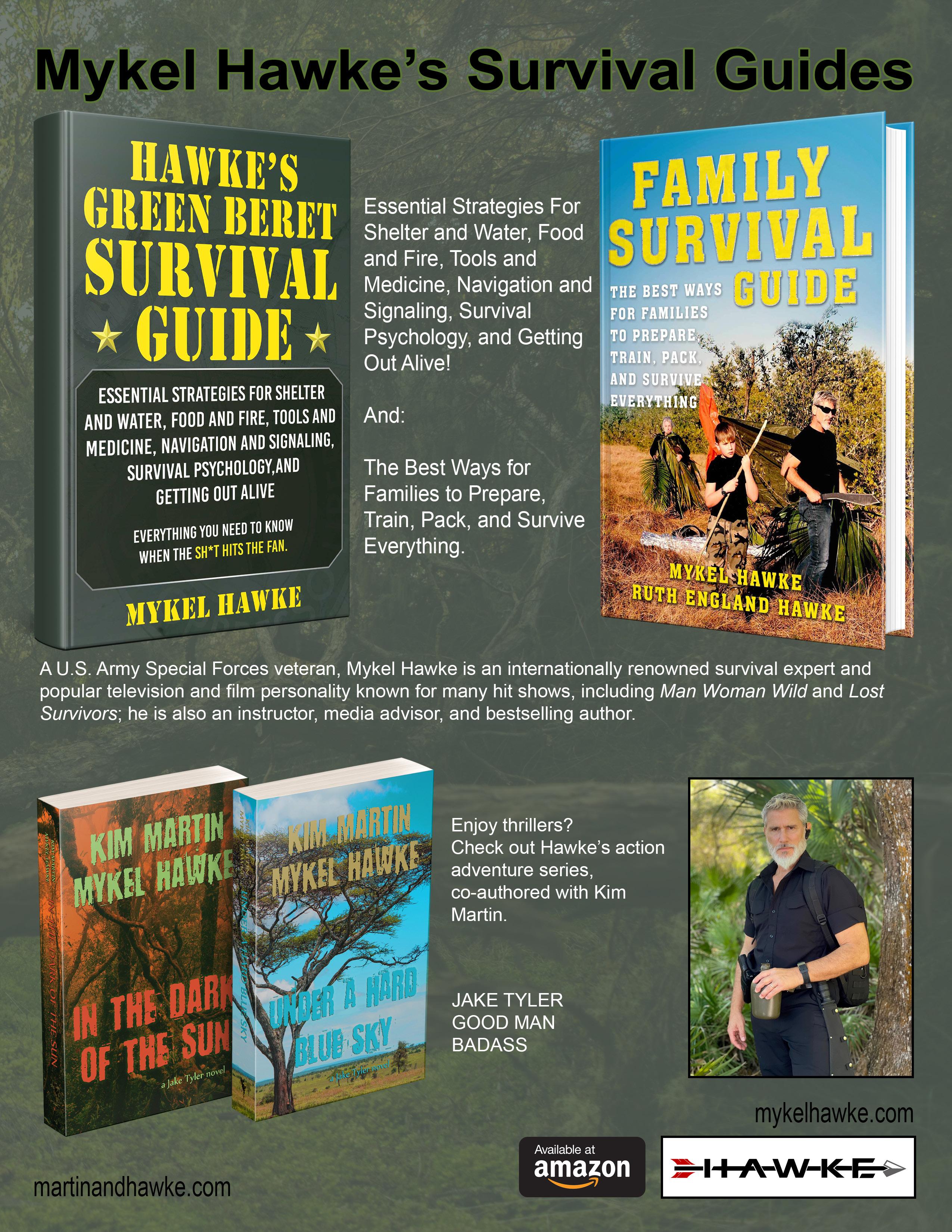
Survival Language
- The Forgotten Skill

Rated by the U.S. Army in seven foreign languages, Hawke gives some advice to pick up languages quickly and effectively, and their major applications to survival.
By Mykel Hawke
When it comes to survival, prepping and readiness, an often overlooked but seriously critical skill is language. I know what you’re saying: how is a language going to help me survive? First off, it sure won’t start a fire, admittedly, but let’s look at how it might just!
Firstly, if you are not leaving the country, how can a foreign language help you survive? Consider the possibility that you are lost. What if you are hurt and need help from a stranger who does not speak English? What if it is a mass disaster and good folks bump into you but only speak Spanish or some needy people are trying to steal some supplies because they don’t know how to ask to barter or trade? Language skills at home could actually save your life or help others in circumstances like these.
Now mostly, in the United States, Spanish is the best foreign language to study as it has the most potential for use, but if you are in Louisiana or the Northeast near Canada, French might serve you better. On the West Coast, Chinese might be the preferred survival language to study. In any case, asking for a lighter in the language could indeed help you get a fire started. Touché!

Secondly, and most realistically, you only need a second language when you travel, right? Most people who start studying a foreign language get put off shortly thereafter for one main reason: time. It simply takes too long to get functional. Unless it’s a serious passion or professional pursuit, life often demands our attention in areas that will have a more direct impact on us.
I propose the reason it seems to take time is technique. Most teachers and written instructionals operate on the logical premise that you want to become fluent. That demands a strong foundational base which requires a lot of time. In short, they start with the alphabet, then grammar rules and it could be months or years before a student gets to really use the language.
Photo by Kampus Production
As a former Green Beret, we would often be deployed on short notice to strange locations around the globe, often where no one spoke English. Frequently, we did not have an interpreter or linguist on the team with that language, as well as no translator and, back then, no software or apps. This made for a lot of challenges and misunderstandings. Sometimes with hilarious results and sometimes not so much.
I spent a year in language school for Russian and was an honor roll student. I was then sent on emergency missions to places like Turkey and had to quickly learn that the language as well, since we had no team interpreter, or “Terp”. After a few of these missions, I quickly saw that there was a pattern of what was actually needed. I then set them down on paper and saw a pattern of how to speak completely functionally. It was not
perfect, but it was mostly grammatically correct. I certainly wasn’t going to sound like a native, but I wasn’t trying to be. Often, I spoke like a simple child, but ALL my thoughts could be conveyed, and my mission could be accomplished. That’s the way learned how to learn languages fast. It still requires some time and effort, but it’s not hard and you can start functioning on day one and in one week you can communicate the basics!

There are many books, apps, CD’s and DVD’s on how to study that teach you the language info you need. I’ll cover some of those, shortly. However, the secret to learning a foreign language quickly is use. How does one use what they don’t know? Learn it, but not in the conventional way. Learn it the guerilla way; the stuff that matters.
If you were to analyze your own vocabulary in the course of a normal day with family, friends and co-workers, you would find you only use about 200 words. So, why not focus on those so you can
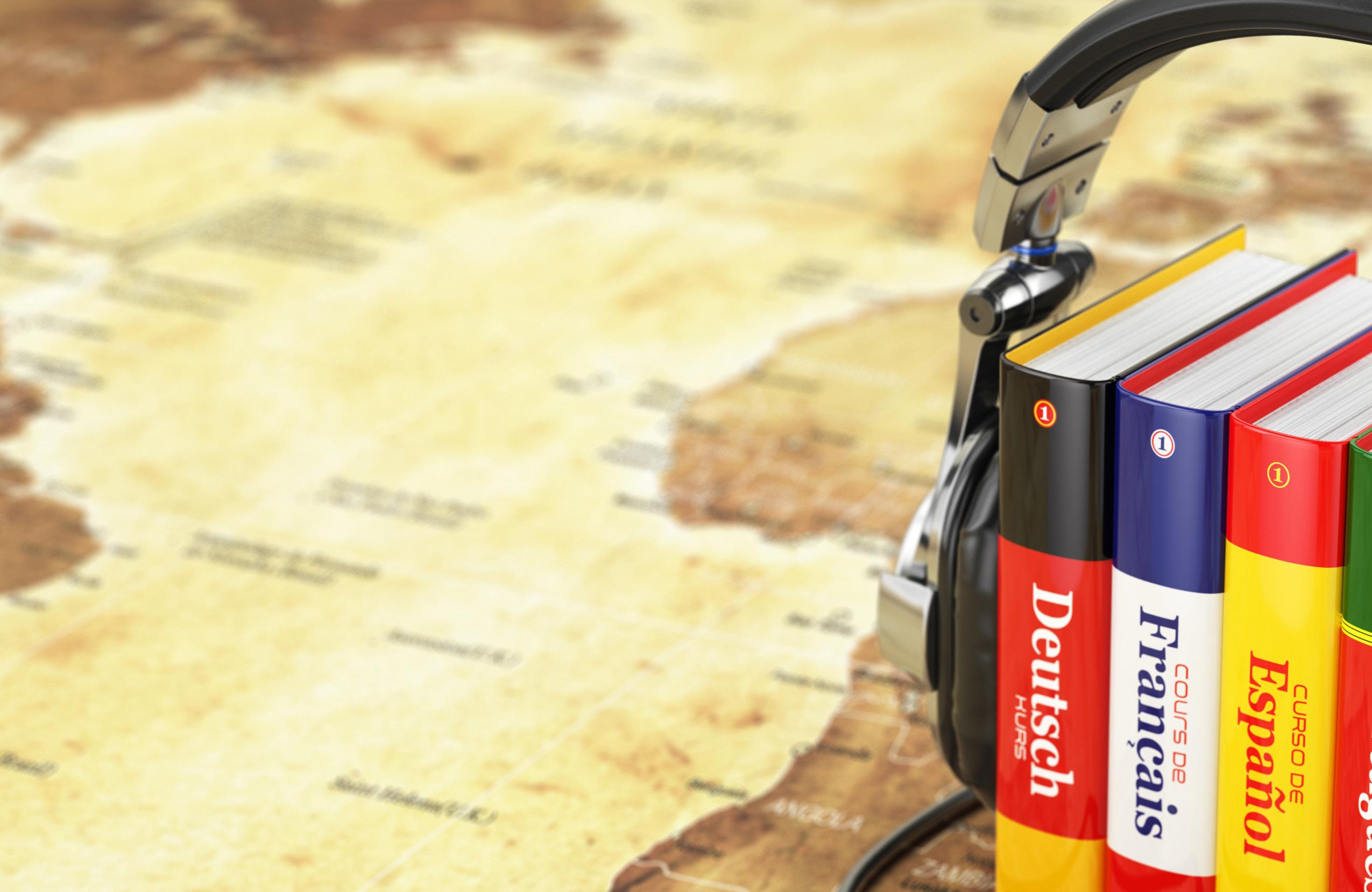
speak in another tongue? I won’t get into what nouns and verbs and adjectives and adverbs are or into a lot of grammar, those are for the books. However, what you need are a handful of nouns- like the word for “people,” “place” or “thing”. After that:
Then you need a handful of verbs like, “to need,” “to go” and “to do” Then a handful of adjectives like, “good,” “bad,” “big,” “little” in opposites. Then a few adverbs like “well,” “poorly,” “quickly” and “slowly”. Then a few prepositions like, “in,” “out,” “above,” “below,” etc.
After that, you will need to start with only two conjugations- “I want” and “you want,” for example. Many languages have a root verb that changes according to who says it. Our language does a little bit- I want (no “s”) versus she wants (with the “s”), is an example.
We’re almost done! Next, you need a few key words that convey the sense of time. Words like “now,” “later,” “today,” “tomorrow,” “yesterday,” “before” and “after” are great for most things.
Really important are the interrogatives: the questions! Who, what, when, where, why, how and how much! With these, a few pointing fingers and a map, pencil and paper can go a long way! Then make a list of key nouns you’ll need like food, water, help, etc.
Finally, it never hurts, and always helps, to learn how to say please and thank you! If you open every time with “please” and close with “thank you,” no matter how badly you hack their language, they will know you are foreign, see you are trying and hear that you are polite and will often help. The last thing here but the first thing you should do, is learn the traditional phrases like “hello,” “goodbye,” “my name is,” “What’s your name,” etc.
Putting it all together, it may look something like this: Hello, my name is John/Jane. I need water. Where, please? Thanks.
Bam! Day one, speaking and communicating.
Now, pick your language and let’s look at some tools to help get you there. An hour a day is a good start.
Books-

A dictionary is key but start with a kid’s one as it will help you learn how to pronounce and conjugate and provides simpler words to use.
A phrase book that shows the language, your language and how to pronounce the foreign language letters in your own language. Letters are vital to faster learning.
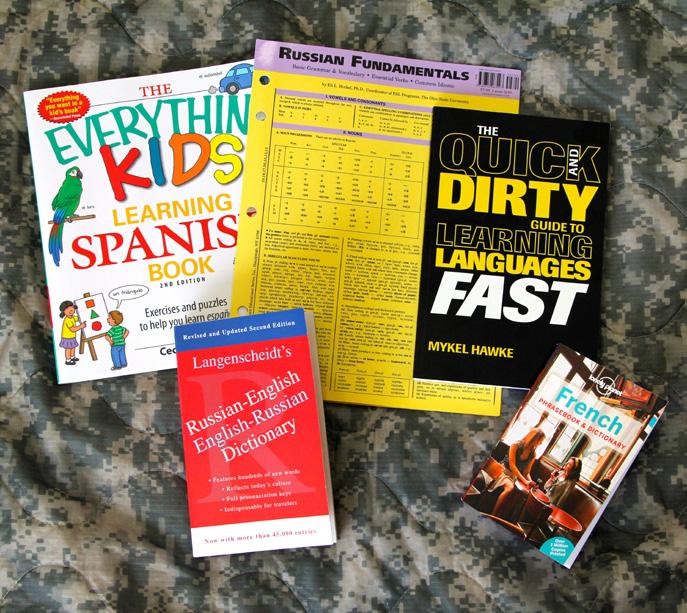
MusicBuying some slower music, maybe even kid’s songs, is a great way to help your ear and brain adjust to the language and pick up words. Download them on your phone or computer and listen whenever you can.
MediaI recommend watching some kid’s shows in the target language. Buy some DVD’s or watch some
Photo by Christina Morillo
Photo by John Dowd
Photo by Bet Noire
online and download them onto your phone or computer so you can watch them when traveling or not connected to the net. Also, if you have satellite radio or TV, try to find that in your language.
APPSThere are so many great apps for learning languages and a lot will depend on if you want a free one or to pay for one. Usually, the premium ones you pay for are ad free and work better.

Even if it sounds like machine gun rapid fire, the more you listen, the more your brain gets attuned and reprogrammed to pick it up. It’s called passive learning and writing, or speaking, is active learning. There are apps that can see the language with your camera, or ones where folks can speak into your phone, and it will translate the words. These are awesome, but often very slow and flawed. Plus, if they are not connected to the net, they don’t work.
As a survival guy, I recommend a few of each. It is especially important to have apps that work offline, to always carry a tiny dictionary with real, grown up, words and a small phrase book. Often, a good person who sees that you need help can find the word in their language, and then show it to you. This way, you can work it out together.
Lastly try “long haired dictionaries” and/or “six pack dictionaries.” I.e., People. One of the best ways to learn is with another human being. For single folks, this can be awesome even if sometimes frustrating. Nothing motivates you better than to want to speak to someone you care about and nothing helps better than someone who cares about you. Smarts are a factor here. Some other notes:
With Translators, whether you are using a translator for professional or personal reasons, it is important to pay attention. You want to learn from
30
Photo by Ineskoleva
them while they speak, of course, but you also want to make sure that they actually understand you! If you offer a dollar to a beggar for example, and you watch your “Terp” make mean gestures and then see the potential recipient get angry or afraid, then you know something isn’t right! It may be that your “Terp” is from a tribe that hates the other person, and you just joined a war, or it might be a simple misunderstanding and your words asked for a dollar instead of offering one.
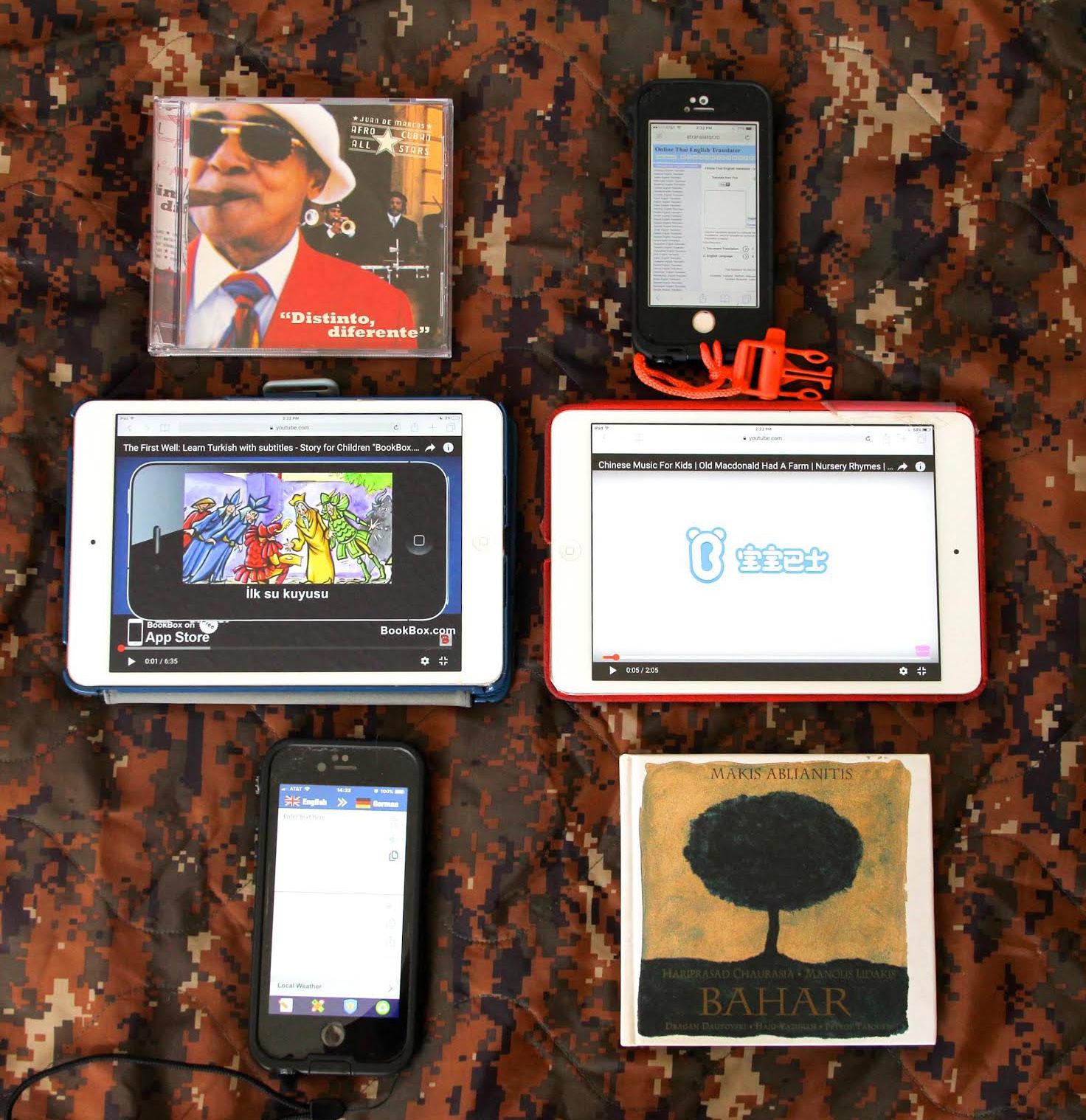
With Gestures, some can get your butt kicked or get you into a fight and then in jail; where you may even be executed. A simple “OK” sign in America is calling someone an “A” hole in other countries. Do your homework.

With cultures, another thing that can actually get you killed is to not study the culture of the language you are using. Some places, get highly offended if you stop and ask a woman for directions for example. Be smart! Learn the signs of other cultures if you plan to travel there. Not everyone uses U.S. & EU style signage.
Also, some cultures yell as a way of communicating. Don’t take it personal and get offended. And please note, yelling doesn’t make them understand you any better. Don’t get frustrated and become the ugly American. Learn, be patient, stay calm and expect mistakes. Have a good sense of humor! You will get through it and may make some lifelong friends along the way. But for sure, with some language studies, your chances of survival will increase and you may live to tell many funny tales!
Photo by John Dowd
Photo by Oleksandr Pidvalnyi
Winter Vehicle Survival
When it comes to winter survival around a vehicle, traveling far or not, there are some key things to keep around and in mind. Snyder gives his thoughts and some lists to keep handy to prepare.
By Ej Snyder
by Olof Nyman

Winter is coming… are you ready? As colder weather approaches and the last leaf has fallen, it won’t be long for many before that white stuff starts to fall, temperatures drop and Old Man Winter’s icy grip grabs us. Now is the time to get your winter survival hat on and get prepared for it! You definitely do not want to be caught out in the cold “Naked and Afraid” without a good plan and the winter vehicle survival kit that will help you deal with a winter emergency while out and about. A good winter vehicle survival kit will help make the situation easier to manage, aid in being self-reliant and heaven forbid… save your and your loved one’s lives. There are more than 2,000 crashes in wintery conditions across America annually. Each year, 24 percent of weather-related vehicle crashes occur on snowy, slushy or icy pavement. 15 percent happen during snowfall or sleet. Over 1,300 people are killed and more than 116,800 people are injured in vehicle crashes in these conditions. Five times that many wind up stuck or stranded along their routes. If you survive a winter wreck, get stuck on the side of the road in a ditch or from a breakdown in your vehicle… now what?
Like all survival situations that haven’t happened yet, it is all about preparation. You can save yourself a lot of pain and grief by taking a few steps to help make sure you don’t wind up a statistic or if you wind up in a bad situation, give you a snowball’s fighting chance to make it out of there. Preparation is everything and key! It starts with normal vehicle checks, putting together a basic vehicle winter survival kit, a basic survival kit, your own personal item backups, mental preparedness and planning for that winter vehicle survival scenario. I am going to offer you
Photo
some tips in this article to aid you, but it all starts with a good mindset, planning and preparation; it’s all about staying calm and executing your plan of actions you have planned.
PLANNING AND PREPARATIONS:
MINDSET – You want to put some thought into the “What- ifs” scenarios that you may encounter. As you think of stuff just jot it down on paper and make short lists that will get you thinking about plans of action for them and certain items and gear that would help in that scenario. A little basic first aid training, getting some basic survival skills and even gathering books of reference material to have on hand to help when things get stressful. Getting your mind in the right frame makes everything else flow better.
1. Get some basic skills training in first aid.
2. Get some basic survival skills knowledge.
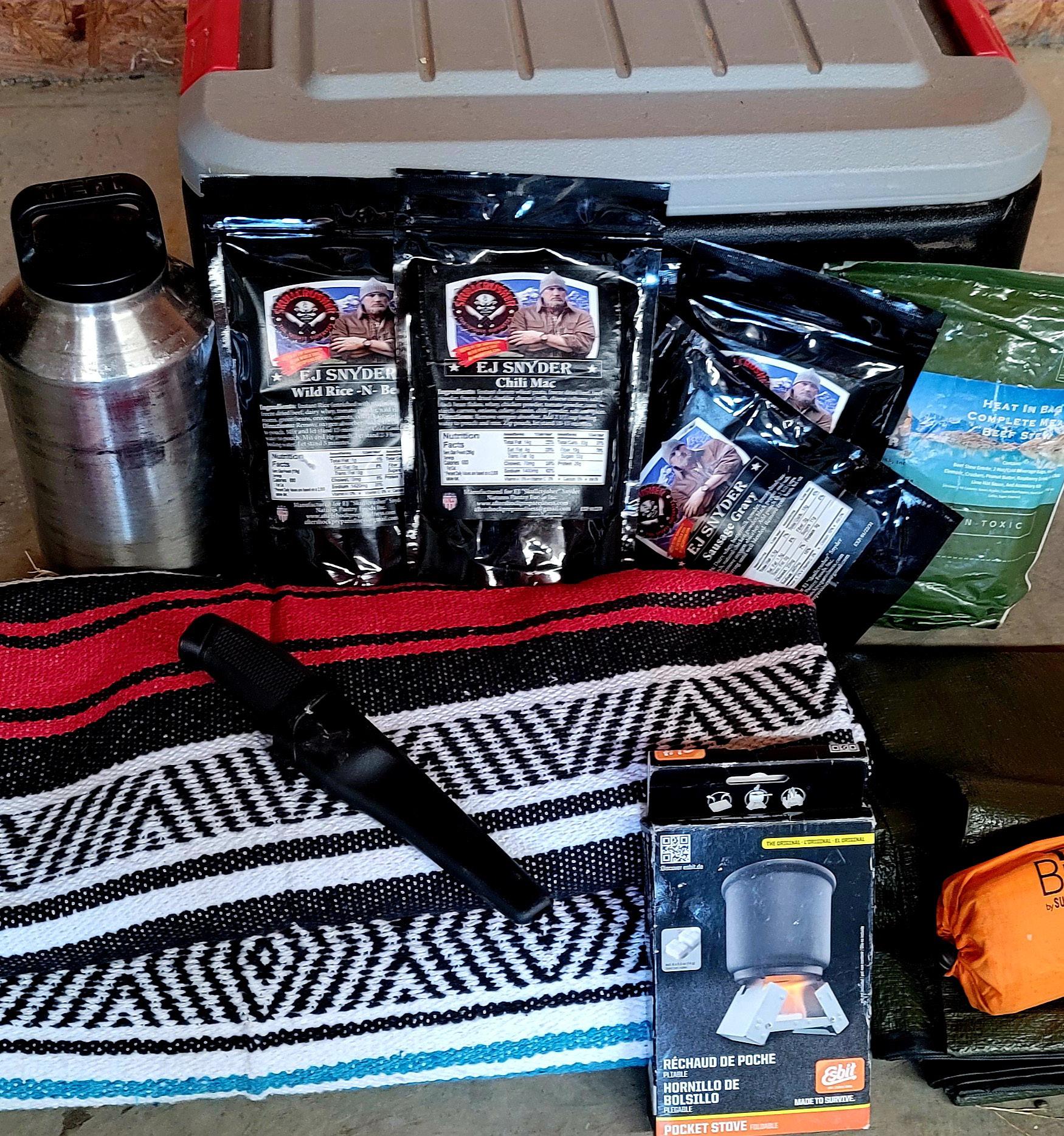
3. Mentally work through emergency action plans and write them down if you need to, as having something written down to look at takes away stress, gives you peace of mind and you have a ready-made action steps list to execute in that scenario.
ON YOUR PERSON – Stepping out your door in the winter, you need to have the “mindset of winter survival” already in your head. This starts with proper winter clothing in layers, even if you are getting into a vehicle, you need to think about the “what-if” in which you may have to walk. You can always bring extras with you. It is better to have and not need than to need and not have!
1. Proper winter clothing. Bring a coat, hat, gloves, underlayers and boots.
2. Have a fully charged cell phone with a backup portable charger fully charged.
3. Have all your roadside assistance contact numbers and membership cards ready.

4. Carry your IDs, credit cards and have some cash on hand just in case you need to tip a good Samaritan that may help you.
VEHICLE – Your vehicle needs to be winter ready and that starts with making sure it is “Road Ready.” No matter what type of vehicle you drive, you need to
Photo by Ej Snyder
Photo by Magda Ehlers
ensure it is mechanically right. Having a good running and properly equipped vehicle makes things safer for you on the road, can eliminate one issue that may cause a breakdown and, in some cases, easier to operate in bad winter conditions which in turn will hopefully keep you from getting into an accident. Your vehicle may also become your shelter in a Winter Vehicle Survival emergency!
Now we can debate all day long in this day and age about gasoline vs electric powered vehicles (EV), but my personal and professional opinion is that you can fair better in a gas vehicle over an electric one in these types of situations. You can always carry extra fuel cans, where I haven’t seen any portable electric recharge setups. If you’re stuck and your rationing gas to stay warm, you can refill with your extra cans, but once an EV is done…so are you, sadly. Roadside assist carries extra fuel, but I don’t think they are equipped with recharge capacity. Batteries during the cold always tend to have issues in normal gas engines, and I have yet to find any studies on the effects of EVs in the winter. Lastly, I believe it’s easier to find gas stations out there than charging stations.
1. Tires are probably the most important for winter driving. What type do you have and what tread condition? Are they snow tires or off-road? Do you have snow chains on hand? Proper inflation?
2. Check all the fluids to ensure they are at the proper level. You should use de-icing windshield washer fluid for your vehicle. Always top off your vehicle with gas and have an extra fuel can in your trunk, cargo area or truck bed. Have your vehicle winterized before the season hits and make sure radiator fluids have been flushed.
3. Check for proper wiper blades and operation.
4. Check lights and turn signals.

5. Make sure your battery is good and not expired, as batteries can act really funny in the cold, especially if it is an older battery.
6. Check to make sure your heater and defrost are working right.
7. If you have four-wheel-drive, make sure it’s operating properly.
8. Have a flashlight and extra batteries. I also have a Husky portable shop light that is magnetic and has an adjustable folding stand.
9. Keep a basic first aid kit and fire extinguisher.
10. Have a vehicle road kit on hand, ready to go as well as jumper cables, flat tire equipment, Fix-AFlat, a portable air pump compressor and a working jack. Have a basic tool kit and I like to throw in a roll of duct tape and gorilla glue. An emergency kit with road flares, warning triangles, reflective vest and tow straps.
11. Bring towels and extra rags.
12. Have a machete or hatchet for clearing debris.
PERSONAL SURVIVAL KIT – You should always have a basic survival kit on you, whether in your purse, backpack or a full kit itself. So that you are always ready for any survival situation, the kit needs to, at a minimum, cover a couple of ways to make fire and purify water, contain an edged tool for tasks, cordage for shelter building with a good tarp, navigation items and a few passive ways to get food. You can stop by my survival gear store for ideas, gear and ready-made kits.
VEHICLE WINTER SURVIVAL KIT – Now this is where the rubber meets the snow folks! The vehicle winter survival kit is “the thing” that will save your frozen butt in a winter vehicle survival situation. It may seem like a lot, but the things listed here are food for thought and there are other ways you can go. These are just suggested carry items. I have found several ready-assembled kits on the market ranging in price from the basic Lifeline AAA Premium Winter Safety Kit at $49.97 to the Winter Cross Country at $79.95 and there were a few others priced in between this
found at Lowes, Home Depot and online. You can just grab one of these to start, if you don’t have time to shop and build one yourself, and then add to it. Building your own means you get to pick the individual items, price them out and determine the quality of the items. Some of these may include:
1. Snowbrush and or ice scraper to keep your windows clear.

2. Portable snow shovel with an adjustable handle, a folding camp shovel or an actual snow shovel to dig your vehicle out if need be.
3. Regular axe for getting firewood if needed.
4. Cat litter or safety absorbent which will help weigh down your back end for extra traction but also to place on the ground by your tires to help get you traction when you find yourself stuck.
5. Bags of ice melt also add back-end weight for traction and will melt any ice keeping you stuck.
6. Extra tow straps and/or rope to help with vehicle extractions.
7. Blankets, and I recommend wool as they keep you warm even when they get damp or wet. I suggest keeping one per vehicle occupant capacity, plus one extra to help keep everyone warm. (You may be called to help others).
8. Extra clothing, hats and gloves to back up what you already have in case something happens to your primary set. I always have these in a water proof bag easily accessible in the cab of the vehicle to grab quickly. Also bring extra winter boots if you are not wearing them while you are out.
Photo by Alexandra Bakhareva
Photo by Aleksey Kuprikov
9. Extra water but remember it can freeze, so I suggest having a small camp stove with a pot ready to melt it down.
10. Heavy Duty Tarp which can be placed over the top of the vehicle cab roof to help trap in heat. It can also be a makeshift shelter, extra blanket and has many other uses.
11. Food. You can pack a small amount in a box of non-perishables like granola bars, protein bars, canned goods, jerky, nuts or dried fruits. MREs (Military Meals) are a good option because they come with a non-flame meal heater that only needs water. You can also have dehydrated/freezedried camp meals, but these will require a way to heat and rehydrate them.
12. Candles are a great item to have. Keeping the vehicle running to stay warm can be dicey. For one thing, you’ll eventually run out of gas (though your car can run for a few hours on a full tank) and you’ll need some fuel to get your car moving again, when help arrives or when the weather clears up. More importantly, snow and ice can block your engine’s exhaust and lead to deadly levels of carbon monoxide in the vehicle’s cabin. So, make sure you pack a simple candle-powered heater. All you need is a metal can (like a coffee can), an emergency candle and a lighter. A candle can make a surprisingly effective ad hoc heater in the confined space of a vehicle and can raise the inside temperature by 5 to 10 degrees at least.
13. Emergency Blankets. These mylar blankets trap
Photo by Ej Snyder
your body heat and have other uses. If you are stuck long term, you can duct tape them up on the inside of the vehicle to help trap your body heat in or have it work in conjunction with your candle-powered heater.
Good planning and preparations go a long way to set you up for success in a winter vehicle survival scenario. It all starts before you leave your driveway, ensuring your vehicle is working properly, you have your basics covered with the right gear and you know how to use it all. You leave with peace of mind, some confidence and your rear end covered. Now, let’s talk about your actions going down the road.
ACTIONS TO SURVIVE BY:
DRIVING – It starts here with being extremely cautious and paying attention to the road and conditions. This will keep you from ever even having to break out any of your kits in the first place.
1. The road is going to be slick with snow, slush and ice, so slow down first off. Visibility could be degraded based on whether snow is falling, how hard it’s coming down and the density of the amount. Slow down and proceed with caution.
2. Ice will form around shaded areas, overpasses and bridges and the worst is black ice as it blends in and is very hard to see. Speed needs to stay in check and 45 mph is usually the max safe speed in extreme conditions!
3. Other vehicles ahead of you could be having issues, there may already be wrecks ahead,
 by Harrison Haines
Photo
by Ej Snyder Photo by Ej Snyder
by Harrison Haines
Photo
by Ej Snyder Photo by Ej Snyder
vehicles stuck or stalled or roads not properly cleared. All these things create hazards to you and your reaction time will be less than normal.
4. If you find yourself in a skid or slide, you need to take these actions: First remove your foot from the accelerator, as using your accelerator will spin your vehicle’s wheels and make the situation worse; it’s the last thing you want to touch. Avoid slamming on the brakes as that can cause the vehicle to abruptly go into a spin. You then steer into the skid by turning into the slide. Try not to oversteer. This means that you should turn your steering wheel in the direction that your back wheels are moving.

CRASH – During winter hazard conditions these will happen. You just need to try to stay out of them!
1. If you so wreck into another vehicle and everyone is ok or has only minor injuries and there isn’t anything life-threatening going on with the vehicle like fire, stay inside the vehicle until help arrives. This is much safer because the conditions are bad and you don’t want to be out where other vehicles coming your way may not see you walking around. Call for help.
2. If you are off the road, make sure you are not in danger of going into a water body. If you are and do, try to evacuate as fast and as safely as possible. Remember to grab that waterproof bag of extra clothing in case you get wet. Again, be cautious getting clear of the vehicle for oncoming vehicles, as they may hit the same
trouble you did, and soon be heading your way. Look around and stay aware when you are assessing yourself and your occupants, as well as vehicle damages. Call for help.
3. If you have crashed into a tree, utility pole or other objects, try to look out the windows and check for other hazards, like a large tree branch broken that may break off and fall, downed power lines or other hazards before exiting the vehicle. Call for help.
WINTER VEHICLE SURVIVAL – Now this is where all your preparedness and planning come into play!
1. Now is the time to assess your situation.
2. If you can self-rescue, get yourself dressed for it and take the actions needed depending on the issue. You may be stuck and able to dig yourself out or lay down some kitty litter for traction and get back on your way. You could have a good Samaritan come by and use a tow strap to help pull you out.
3. Cell phone time! Depending on where you are and the weather conditions, you may not have a signal on your cell. If you do, you should let a family or friend know what’s going on. Try to get them your location so they can direct help your way. Next, you should try to call for help as well. If you don’t have a portable cell charger or a car charging plug, you may want to consider trying to save battery power for your only form of communication. If you have more than one cell phone with you, turn all but one off.
Photo
4. Check to make sure the exhaust pipe isn’t buried or covered up, so you don’t have a carbon monoxide issue while the car is running. Know the signs of carbon monoxide poisoning. If it’s an issue, turn the vehicle off. Better safe than sorry.
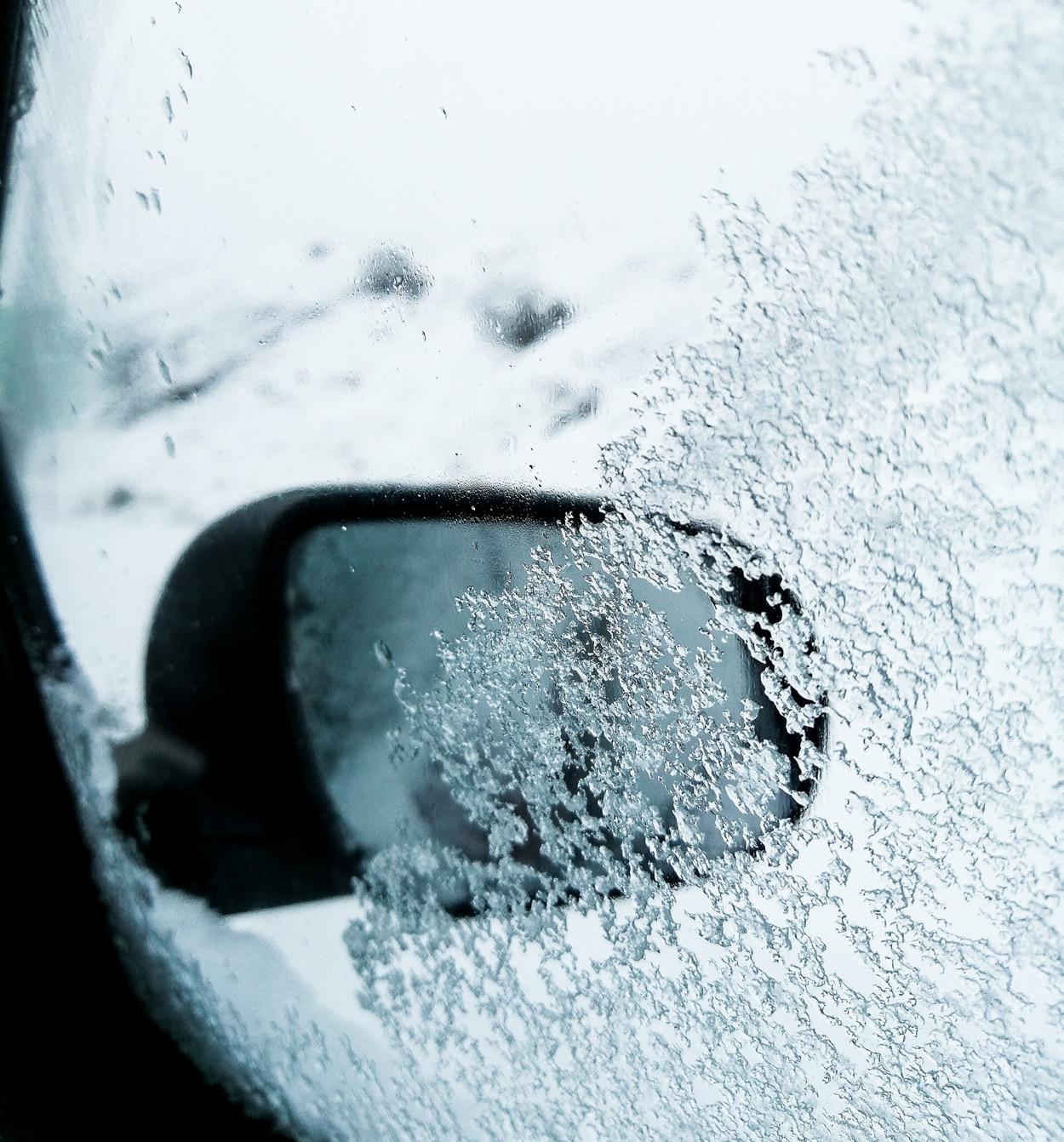
5. Assess your situation and if it looks like you are going to be there a while before help arrives, or find yourself out in the boonies and it could be a substantial amount of time before any help may arrive, it’s time to get settled in for the long haul. Break into your winter vehicle survival kit and make use of items like blankets, extra clothing, etc. Keep everyone as warm as possible, stay hydrated and eat some food. Monitor everyone as things progress you may need to take other actions to keep everyone’s core body temperature warm and make sure you know the signs of hypothermia.
So, Survival in a Vehicle in the winter depends on you, your planning and preparations and your actions to determine whether you will make it out alive or not. You need to stay calm and keep your head in the game. Know basic first aid and the signs and symptoms of trouble. Get some basic survival skills training. You don’t need to be an expert, but some base skills can save your butt out there. Get your vehicle online and running right. Build kits with quality gear so when you need it, it’s ready! Your winter vehicle survival rests on your icy shoulders, so be the ice warrior in the situation and slay the frosty dragon if it comes preying on you the next time you may be stranded on the road in a blizzard! Survive on!
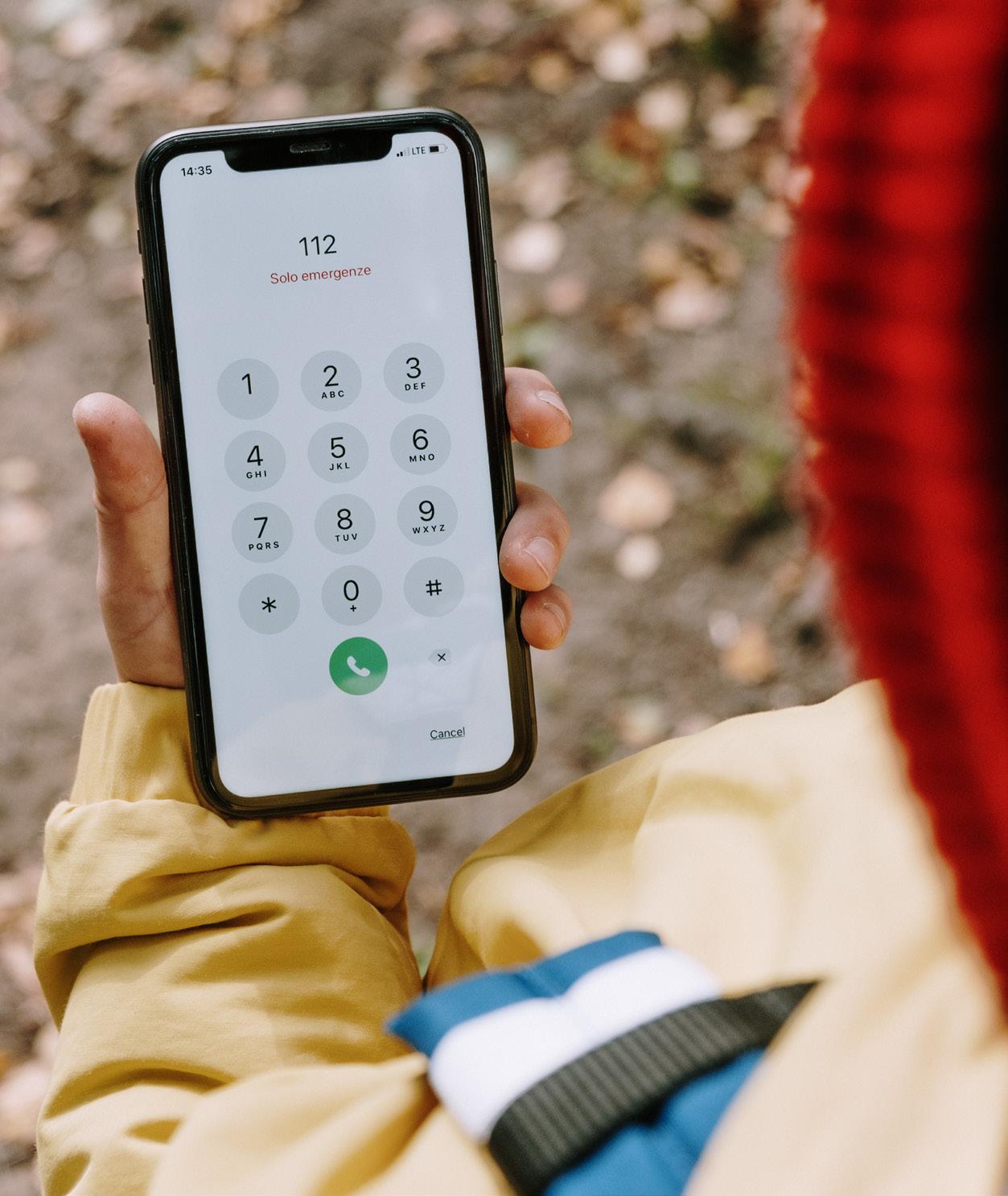
38
Photo by Cottonbro Studio
Photo by Osama Muslih

In a survival emergency, some of the very first moves to make are to find a proper location for camp, build a shelter and make a fire as soon as possible. As many already know, the ferro rod takes some practice to master and a certain level of precision to successfully utilize. When combined with things like high-stress, adrenaline, tunnelvision, impending darkness and possible illness or injury (which commonly occurs in a wilderness emergency or are the cause of the emergency in and of themselves), jumping right to the ferro rod can create some problems. To add the cherry on top, with the possibility of hypothermia (the main and early symptoms of which include shivering and loss of fine motor function), unless you keep a striker with your rod, you are now fiddling around with a sharp knife. Under these conditions, that could result in adding a severe hemorrhaging incident to the equation.

In these situations, the survivor must get warm immediately by making a fire quickly, easily and safely. Now, I recommend also packing a lighter. However, some fine motor function issues can arise here as well, and lighters can also become useless if wet. This is why waterproofing kits and gear are important as well. Here is where the high-quality waterproof storm match comes in.
I personally recommend the UCO Titan Stormproof Match. I am in no way endorsed by or affiliated with the company, but
of all the matches I have tested, these are the only ones that I have never seen fail. They are incredibly easy to strike with little dexterity and no matter how hard you blow on them or how long you submerge them, they do not go out until all of the accelerant is burned off. They also come in a waterproof canister, with a spare striker wrapped in plastic and are larger than the standard size UCO match. This greater size helps mitigate the previously mentioned loss of fine motor function due to things such as hypothermia, high stress or sausage fingers, the latter of which being a condition I was born with. Add a quality accelerant, like a WetFire cube or some other viable option and you will have a raging fire in no time, provided that you have collected the required fuels to build it and keep it going. Collecting fuels is a task that should be completed ahead of time, which even further emphasizes the need to have tools to get fire started quickly and safely.
One might ask, “But Patrick, what if I run out of matches?” To that I say: In a survival situation, if one can help it, ideally a survival campfire should never be allowed to go out completely, even if it just a pile of hot embers. If it does go out and you have no more matches, this is where having redundancies (i.e. lighters, ferro rods) are important. In this case, ferro rods make a great backup.
So, should you carry a ferro rod and a lighter? Certainly.
40
Photo by Rkankaro
by Patrick Norton
Relying on a ferrocerium rod, even the extra-large one pictured, to start an emergency fire can lead to dexterity issues as well as safety hazards.
 Photo
Photo
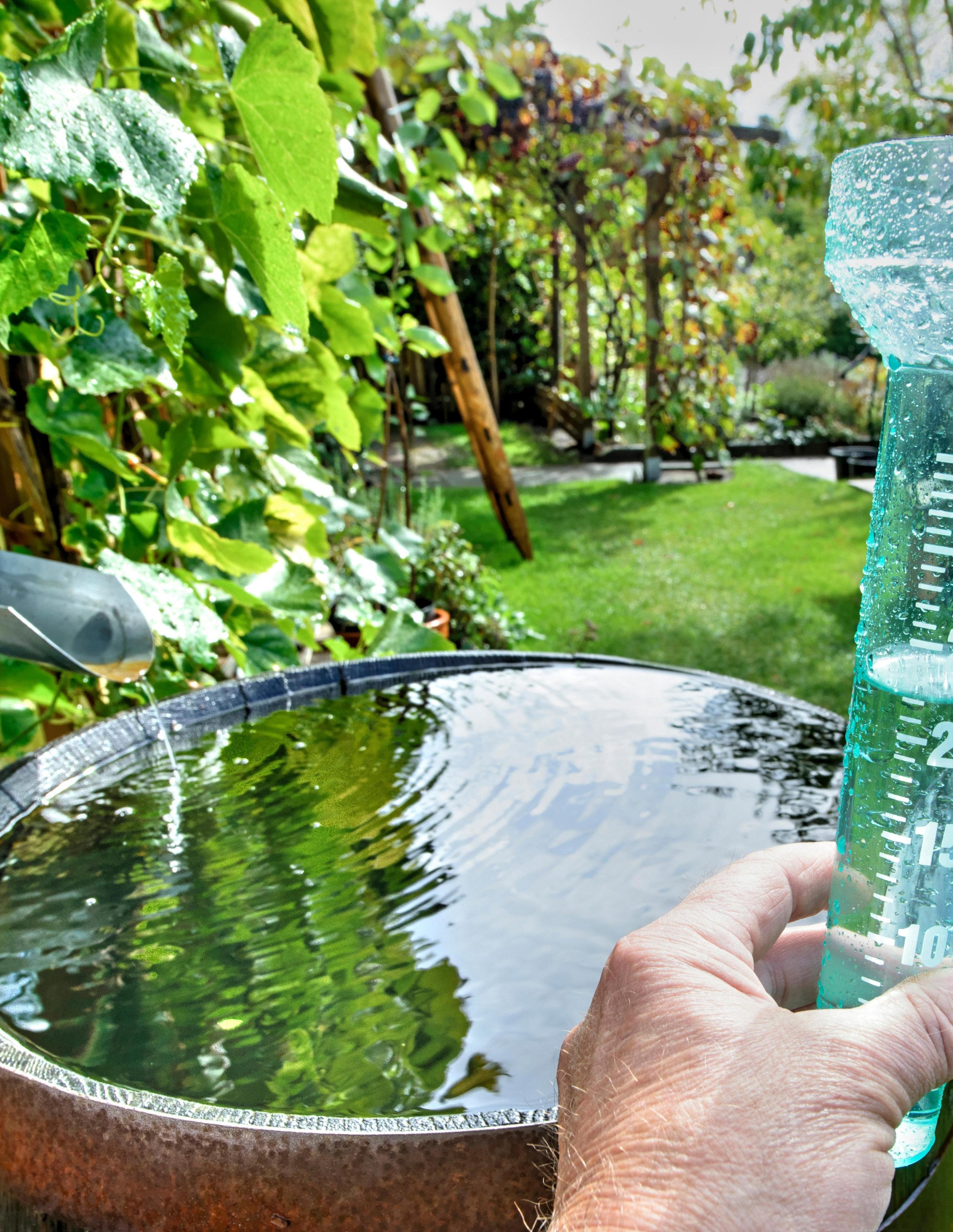 Photo by Schulzie
Photo by Schulzie
Rain capture project for off-grid cabin
Two years ago, my husband Jim and I started building a 12-foot by 16-foot cabin in a remote wooded parcel in Wisconsin. Because it is landlocked, but on a river, we had to float every stick of it, via our aluminum boat. Although I was more of a “Prepper” at the start (which was right about that time “Doomsday Preppers” aired on TV) we now only semi-jokingly refer to it as our “bug-out” location of last resort. I am happy to report that Jim has steadily bought into the idea over the years, and we truly enjoy our time there, pre SHTF. It’s our little getaway and hunting/fishing cabin.
By Yana DeMyer
A year later, we added an eight foot by 10-foot “master bedroom”, which fits two beds and has a door to a small deck outside. It can now actually sleep eight people pretty darn well, as it has two loft areas above. One thing it still lacked was water for drinking and washing up. So, our next project became a rainwater catchment system. While It’s not 100% complete, I hope you will find value in seeing what we designed, and essentially installed, in just one day.
Now, for sure, it took at least five trips to the hardware store for everything which was needed, but at least now we can share with you a list of what we eventually used. Hopefully this could save you much time and frustration, should you wish to build your own.
First let’s talk about our goals. We wanted a system that would:

1) Catch water, filter out leaves and gunk and keep bugs and pests out 2) Let the water be easily purified using a series of products that would: a. Not clog and therefor require filter replacement. b. Guarantee water safety in a non-chemical-dependent way. c. Require only a bare minimum of power to be operational.

d. Cost under $500.
We decided on a rain gutter-based system, which we lined with a sponge filter to keep out the large bits of leaves and twigs. The downspout water is intercepted by a rainwater colander, which has fairly large holes, so, we lined it with a nylon stocking.
DeMyer talks about her experience utilizing rainwater.
Photo by Yana Demyer Barrel top off grid rainwater harvest project.

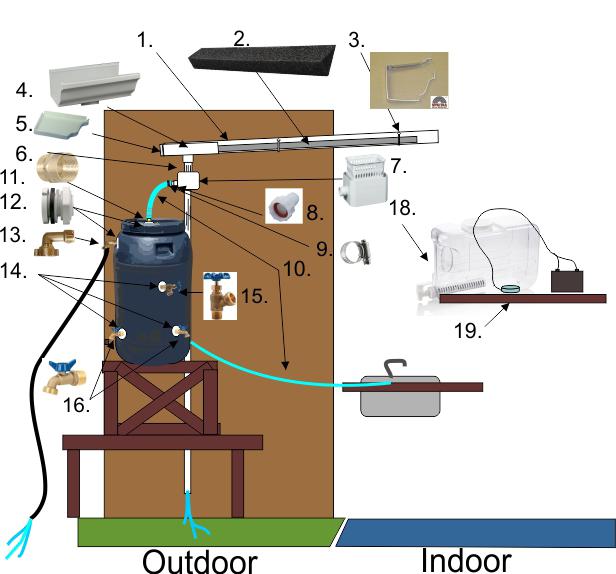 Graphic for off grid rainwater harvest project.
Photo by Maridav
Graphic for off grid rainwater harvest project.
Photo by Maridav

 Graphic for off grid rainwater harvest project.
Photo by Yana Demyer Aerial view of cabin.
Graphic for off grid rainwater harvest project.
Photo by Yana Demyer Aerial view of cabin.
This is what we recommend doing:
Start with drilling a one-and-a-half-inch hole for the inlet bulkhead fitting on the top of your barrel. Install the bulkhead fitting. (11) Next, install the brass fitting (12) that will adapt to your drinking water hose. You can figure out where to place the outlets later once you have your barrel in place.
Next, place your endcaps on the gutters, using metal screws. You can then hang the high end of the gutters on your house. A one-fourth drop per foot is the angle you need and using a string will help you keep things aligned. Work your way to where you want the downspout. Place the end of the gutter where you want the downspout to be and insert your “drop with outlet”4). This will determine how high you can go with your barrel. We wanted ours to be as high as possible, as we wanted to use gravity rather than a pump to get water to our outlet fixtures. It is possible to use barrels lying on their side to gain greater height, but since ours had a screw-on top which we didn’t really trust it to be leak-free. In the end, we decided to use it standing upright.
Once you know how high your barrel will be, build your base for the barrel with two-by-fours and wood screws. At 8.33 pounds per gallon, our pickle barrel is 65 pounds which equals about 541 pounds. Make sure you build it nice and sturdy.
Place the barrel on the stand in its permanent place. We only had about four inches to spare so that became the dimension of the downspout that led into the colander. Cut the down spout (6).
For a good video describing how to do this, check out “Cutting Downspout: Starting the Cut, Making Straight Cuts, Tool Use, Crimping, and Connection!” on YouTube, by AC Service Tech LLC. Then attach the downspout to the outlet with metal screws.

We then attached the colander bracket and then the colander (7). The center of the colander connects to a standard downspout and goes down to the ground. The rainwater collector part of the colander
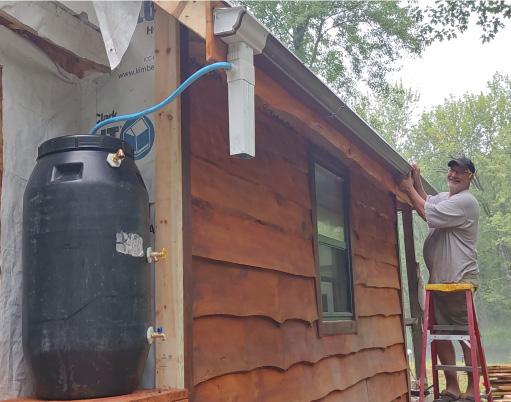
shunts the water to a male garden hose, to which you will attach the first part of your RV drinking water hose. Measure how much hose you will need and cut it. Place the swivel barb fitting (9) in the cut end of the hose and secure it with a hose clamp (10). You can then screw it into colander, and the top of the barrel. The rest is pretty self-explanatory.
You will continue to locate and drill holes where you want your outlets. In our case we wanted one for
inside the cabin, one for an outside shower, and one for an overflow hose near the very top. The parts specified here all connect to garden hose style fittings. The outlets all have shut-offs so you can work on adding in sink fittings, etc., without having to fight the water later on.
You are now on your own for how to attach the garden host to what ever fixture you have in your house. There are just too many ways to do it! As far as making sure the water is safe to drink, we chose a unique new technology that you may not have heard of yet. An electrolytic ozone generator made by a Wisconsin based company, Roving Blue (our invention). We have a small device, called the Ozo-pod 10, which infuses the water with ozone. Not many people know this, but ozone, when dissolved into water, is actually far stronger than chlorine. So, in minutes, a drinking water dispenser such as the one we chose, will be zapped with ozone strong enough to kill any microbes that might make a person sick. The neat thing about ozone is that it quickly reverts to ordinary oxygen. This means there are no chemicals to buy, no filters to clog and no chemicals remain in the water. You can check these out at www.rovingblue.com.
Remember, in some areas, collecting rainwater for human use can be considered illegal, even if there is a clever and effective way to purify it installed. Please check local regulations before attempting. Included is the list of parts we ended up using and a diagram of where they were used that follows the article.

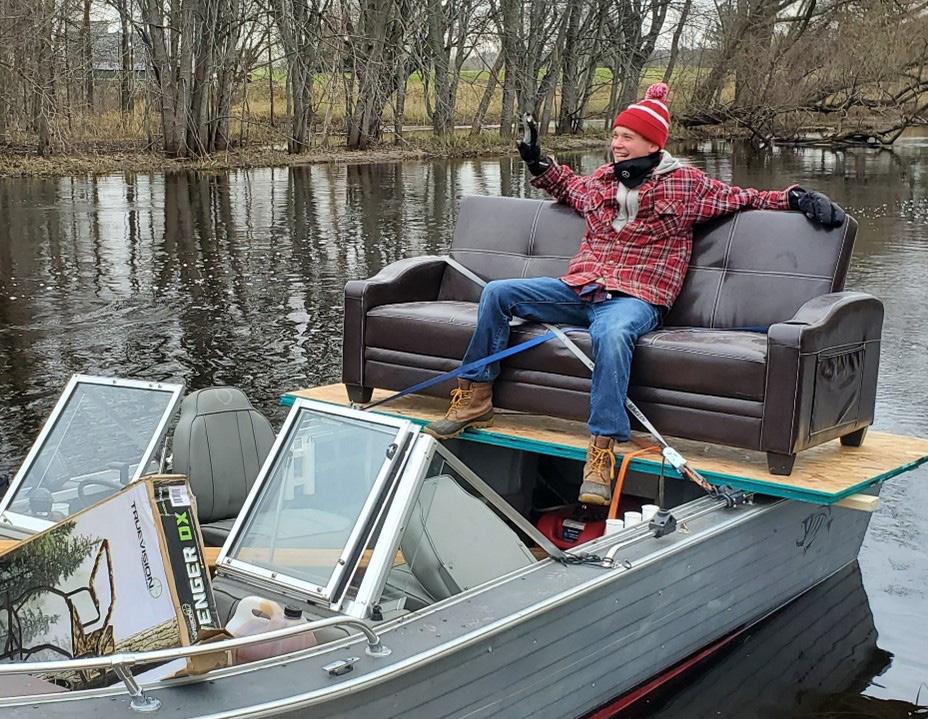 Photo by Yana Demyer Rainwater capture 1 Our son, Spencer, enjoying his perch on the couch we floated it down to the cabin.
Photo by Timltv
Photo by Yana Demyer Rainwater capture 1 Our son, Spencer, enjoying his perch on the couch we floated it down to the cabin.
Photo by Timltv
The world we live in is a dangerous place. The possibility of violence happening in the workplace is a real and present danger. In 1999, twelve students and one teacher were shot and killed at Columbine High School in Littleton, Colorado and an additional 24 students were injured. In 2012, twenty-six people were shot and killed and twenty-four additional students were injured at Sandy Hook Elementary School in Newtown, Connecticut. The likelihood of one of these incidents happening again in the future is likely. Regardless of what the shooter’s motivation is, be it a mental condition, a disgruntled employee, or a terrorist, it is imperative that you know the proper signs to look for, precautions to take, and what your actions should be in the event of an active shooter scenario taking place.
Look for the signs
Start by using your situational awareness to identify pre-attack signs that something is wrong, such as:

• Signs of aggression or threats directed at coworkers or supervisors
• Existence of unapproved weapons
• Severe mood swings
• Depression/withdrawn behavior
• Talks of suicide
• Paranoia
• Strange behavior such as flashbacks
• Drug and alcohol abuse
• Repeated violation of policies in the work place
• Talk of personal problems such as marriage or finances
It is not always possible to predict an active shooter incident and not everyone who exhibits these signs is a potential active shooter. These are just situations to be sensitive of and to notice when someone displays one or multiple signs. In any case, you should report this behavior to your supervisors or to the local authorities, depending on the severity of the situation. Doing nothing is rarely the right answer.
 Photo by Harrison Haines
Photo by Harrison Haines
How to respond
If you find yourself in an active shooter situation, you have several options regarding how to respond. Your first choice should always be to help others to evacuate the area. If there is an opportunity to evacuate, make sure you:
• Have a plan: Make sure you have an escape route in mind before you move
• Leave your belongings, they will just slow you down
• Help others escape, if possible
• Prevent other people from going near the area where the active shooter incident is happening
• Call 911 immediately
• Go out in the direction first responders are coming in
• Do exactly what the police officers tell you to do and keep your hands visible. Evacuating the area
may not always be an option. If you find yourself unable to evacuate, consider finding a place to hide.
The location you choose should:
• Be out of the view of the people or person doing the shooting
• Provide good cover (be able to deflect bullets fired in your direction), such as a concrete wall

• Have an escape route if possible/try not to box yourself in
• Have doors that lock from the inside
• Have heavy objects like furniture to block the door.
Remember to put your cell phone on silent and hide behind the largest items you can find in your location. Stay calm, cool, and collected, and call 911 as soon as you get the chance.
Taking action
In a worst-case scenario, you may find yourself having to take physical action against the shooter.
This is a very difficult situation, particularly if not trained and conditioned in the art of hand-to-hand combat. Still, it may be your last resort in a desperate situation and when innocent people are dying. If this is the case, remember to:
• Have a plan
• Commit to your actions 100 percent
• Be as aggressive as possible
• Improvise weapons if you can find any…throw large objects if they are available
• Get others to help you incapacitate the shooter if possible… several grown men can often combine their strength to tackle down a lone shooter. Taking action against an armed aggressor is extremely risky but it may be your only chance (or the only chance for those you are responsible for) of survival.
What to do when the police arrive
One of the most dangerous times during an active shooter scenario is when first responders arrive. It is extremely confusing for them to differentiate between the victims and the perpetrators when these incidents take place. The best thing you can do when you make contact with the police is to:
• Stay calm and follow the instructions of the police
• Put down anything you may have in your hands
• Raise hands high in the sky so they can be seen by the police and keep them there
• Don’t make any quick or jerking movements
• Avoid screaming and yelling. Maintain your situational awareness so that you will be able to provide the police with:
• Location of the shooter(s)
• Number of shooters
• Description of the shooter(s)
• Type of weapon used by the shooter(s)

• Estimated number of casualties
Being prepared for an active shooter scenario requires not only personal situational awareness but also teamwork, leadership, and practice through response drills as well as continuing education on the topic. In a work environment, actions to take should come naturally through rehearsal and duties and responsibilities should already be assigned long before one of these instances occurs. Additionally, remember, if you see something, say something. All too many active shooter events could have been mitigated or stopped all together had people that observed signs that something was happening out of place and reported those events to the proper authorities.
 Photo by Prot Tachapanit
Photo by Prot Tachapanit
 Photo by David Pereiras
Photo by David Pereiras
Bugging In
Snyder talks about how he stays prepared for a bug-out situation.
By Ej Snyder
by Cottonbro
You hear the term all the time, “bugging out,” and most people believe that when the SHFT that is what everyone will do. However, it’s quite the opposite in my humble opinion. I believe that 90% of the populace will actually stay put and not go anywhere. Those that do “bug out” are only moving to another place to “Bug In” anyways, so everything I am about to present to you applies to both. With that comes the need for home defense as well.

We saw this happen during the COVID-19 pandemic and many folks were not properly prepared to do so. Many people quickly ran out of supplies, food, medical needs and other things very quickly. Store shelves emptied quickly, factories and distribution centers shut down, transporting these things by way of trucks, rail and air came to a halt and so many people in the world were left wondering how they got to this point and how it happened.
All great questions and thoughts, and the answer is very simple...lack of planning! People may say well, this was a once in a lifetime event. But was it? Never make the mistake thinking that a disaster or emergency is not going to come knocking on your door when it comes to you and your loved one’s survival. A myriad of things can happen and will happen. It’s just a matter of when. So, the time is now! This is when planning for these things matters most. The next pandemic, hurricane, earthquake, civil unrest, wildfire, even war, etc. could be just around the corner.
Do not be caught with your pants down, wondering, “why did this happen.” Be the solution to your own problem by acting. You don’t need to be a millionaire to prepare. There are lots of budget friendly options to fit all economic situations. Visit ejsnyder.com to see the “Ultimate Bug In and Home Defense” video for mor in depth information. For now, here are some things you can do immediately to start getting ready! There is a plethora of other related items on my website as well.
So, the first of many things you need to do is assess where you are at in your preparedness level. Start a list, organized by category, so that you can get that survival preparedness laundry list going and fill it up. It is a critical step in the process and will help keep you on track, even sane, and make your needs a lot clearer.
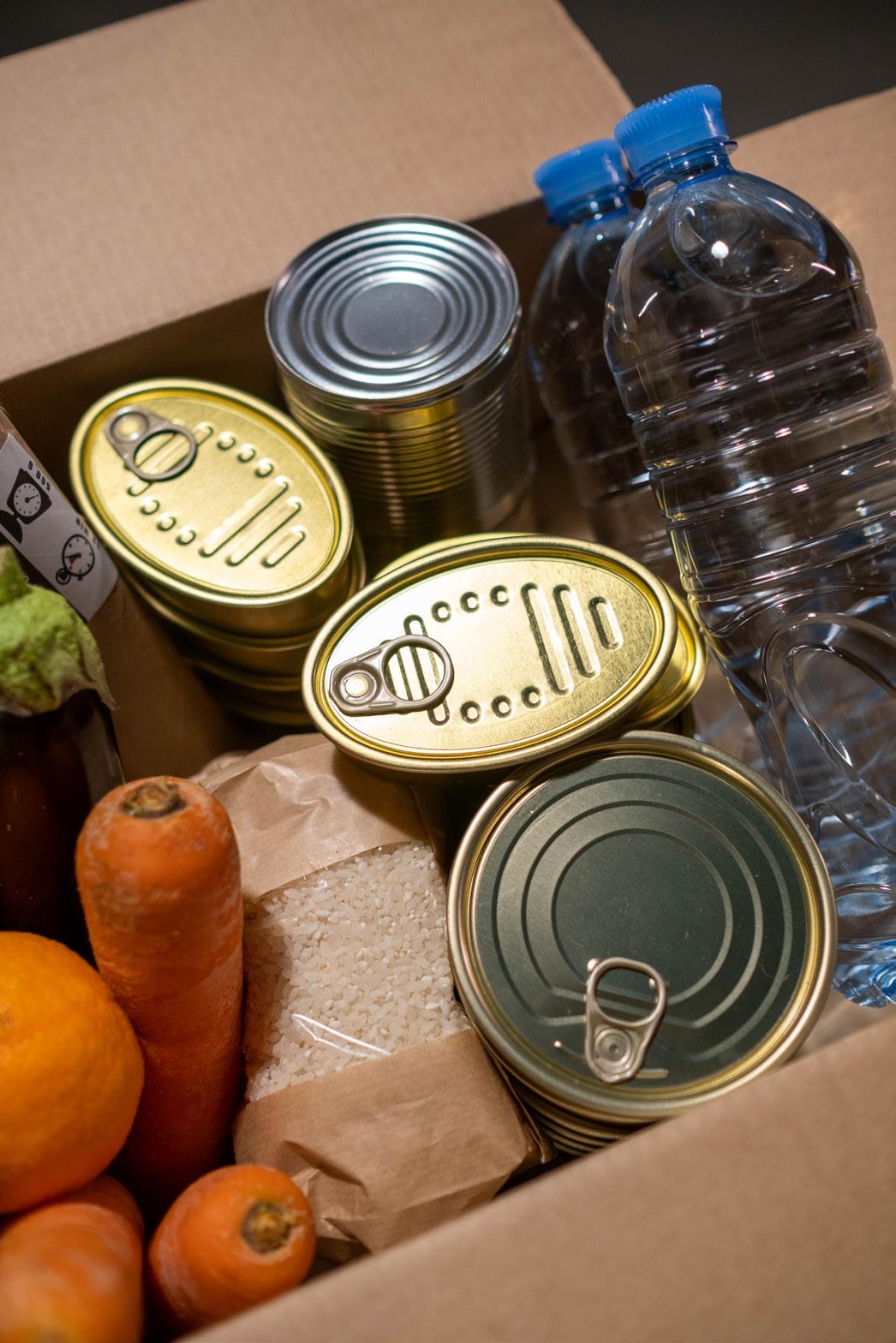 Photo
Photo
I am old school, so I always grab a clean sheet of paper, a pencil and a clip board. Electronic lists are great, but this list is one thing you need to see looking at you in the face every day and often, as a staunch reminder of what you got but more so...what you still need! Here is a sample list and it’s just that, everyone’s list will be different.
Bug-in list: Shelter: - Radio - Extra blankets or sleeping bags - Shelving - Backup generator - Extension cords - Solar chargers - Tent - etc.
Navigation: - Extra fuel for generator and vehicles

- Flashlights - Extra batteries - Headlamps - Compass - Candles - etc.
Water: - Several five-gallon water jugs - Filter system - Water bottles (2 for each person) - etc.
Food: - Extra non-perishables foods and canned goods - Coolers - Cases of dehydrated meals - MREs
Photo by Emfotografia
 Photo by Anthony Acosta
Photo by Anthony Acosta
I even visit those great and abundant dollar stores, as it’s surprising how affordable the items in there are and how many quality items a person can get in large numbers without breaking the bank. You can really knock at that list fast, even if you are not on a strict budget.
When it comes to storage, that also depends on your particular domicile situation. Somebody in a rural area, say on a farm, may have several outer buildings and designate one for their Survival Storage area. Suburban types may have a basement or garage to use. This can apply to a town home. For my urbanites things get trickier, but being a professional hoarder, I can tell you that every nook and cranny counts and can be used.
I usually try to suggest to those in apartment situations to think about getting an apartment for what you need in terms of bedrooms, plus one. This way you have sleep spaces for everyone and one extra room that is usually at least a 10-foot by 10foot size to set up shelving and make it a survival supply storage area. Never forget the laundry rooms, utility closets, attics, crawl spaces and sheds for
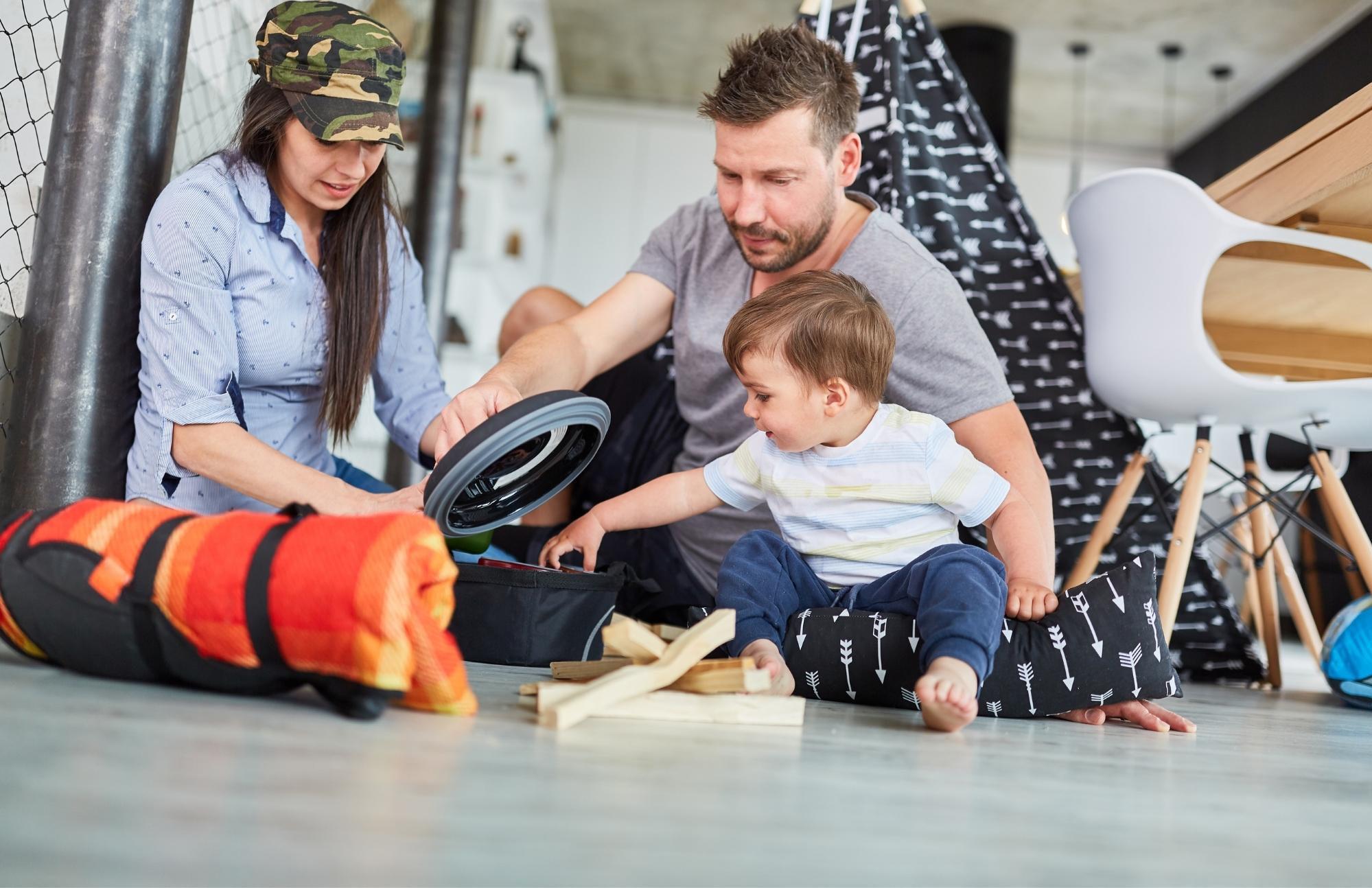
additional space.
I recommend good sturdy shelves. You can buy some plastic ones of different types and sturdiness, or get some metal racks, or build wooden ones yourself. Even wall lockers can work and give you the ability to lock them up for added security. I also suggest categorizing your shelf or storage areas by type: water, food, medical, etc.
All of these tips and things should now have your mind engorged in the planning and stocking phase of “bugging in.” They say, “An ounce of prevention is worth a pound of cure.” That holds true here, and I like to say, “Good planning prevents pain!”
GET TO YOUR SAFE ZONE
Now that you have gotten things straight at your “bug-in” safe zone and things are set and ready for when you and your loved ones arrive, what do you need to actually get you here from where you may be? Well, you never know when, where, how, why or what will cause you to be smack dab in the middle of a catastrophe. Again, planning and
56
Photo by Robert Knechke

and things to consider for your vehicle. Again, user digression is advised, pending various state and federal laws.
“Get-you-home bag” list:
- Vehicle (no matter what your ride is, it needs to be in good working order, serviced, and topped off on all fluids)
- Paper maps (road and topographic)
- Additional communication (optional like a CB, Ham Radio or satellite phone)
- Spare tire with working jack and car iron
- Small tool bag with basic tools in it

- Flashlight with extra batteries
- Road flares (excellent fire starters and signaling devices)
- Extra fuel can, oil and other fluids
- Small shovel
- Tow straps and chains
- Extra fresh water
- Box of Food and a way to prepare it
- Larger tarp,
- Extra rope, cordage or paracord
- Sleeping bag and or blankets
- Possibly another bug-out bag in case of breakdown (beefier than the “get-to-your-car” bag)
- Winter Kit (if in a snowy area, including tire chains, ice melt, snow shovel, candles, winter clothing, etc.)
The vehicle offers a lot of protection from the elements, helps conserve energy and can carry a lot more supplies. The bug-out bag is a very important back up plan for in case your vehicle breaks down or you must bail out of your vehicle due to the situation and must now get home on foot. The argument of what goes in the perfect bug-out bag may never be settled, but for me it’s all about your needs, must haves,
budget, situation and what I call plain old “skullcrushing sense!” This is just like common sense but with attitude.
Now that you are rolling in your vehicle heading to your domicile with a backup plan in the trunk, all is well, right? Wrong. It seems the analogical riot has cut off both your primary and alternate routes. Thankfully, you were planning ahead and have a contingency plan that takes you to a “Hold-up” spot at one of several cache sites you planned for and have in place. So, what exactly is a cache site?
A cache site is a location where you can get to either by vehicle, or on foot, that is off the beaten path, so it does not draw attention. This spot should be hidden enough to keep you safe but easy for you to find, day or night. It should be marked in a way so that if anyone sees it, it doesn’t cause them to investigate it. It should provide some cover from eyesight of others, protection from the elements and be easily defendable.
You will also have already hidden supply caches there in some fashion. Whether you bury your caches or simply hide them by camouflage, you need to ensure they cannot be found and pilfered, because you want them there for you when you need them. They will act as ways to support you without dipping into your vehicle set up or bug-out bag, as well as to resupply what you used. There are many ways to set them up. Where you place them needs to have enough space to hide them or bury them. If you are hiding them by camouflage, you
58
Photo by David Pereiras
can use natural brush. However, over time vegetation dies and turns brown, so I recommend using some military camo netting, or an old canvas tarp that you can spray paint with colors to match the area and season.
I have seen these large fake boulders that look very real in which to hide things. This technique is most vulnerable to theft in my opinion. I personally like to dig a hole and bury stuff. Once in the ground you can cover the cache supplies with an old tarp or some wood and throw the dirt right over top of it. Camouflage the area where it’s buried, and you are good to go. You can mark it in some way to easily be found, but I generally like to make a small strip map of each cache site and pace the buried site off from a known point, like a recognizable tree covertly marked. I also would stash a D-handle shovel somewhere nearby, or in your kit, so you are not stuck using your hands to get to it.
Lastly, I have known folks to just be blatant about it and drop a Connex, dumpster, locker, container or some sort of shed at a spot and just throw a lock and or chains on it. I even knew a guy who used a Port-A-Potty.
Now, the cache supplies themselves can be packaged in many ways. I love old military canvas duffle bags, and I usually stuff the items into heavy-duty leaf trash bags (this is added layer of protection, waterproofing, and preservation) and then tape it closed with duct tape before putting them in the duffle bag to help protect them.
Duffle Bags are generally good for most any items, like extra batteries, gear, food, etc. I also like using footlockers with a lock on them. Plastic heavy duty tote boxes work really well. Place your supplies inside them, separately packaged for protection, then seal them up with Duct Tape. For a third layer of protection, put the totes in heavy-duty leaf trash bags before you are done. All these steps help protect your supplies from the elements and wildlife.
For things like fuel I just use the plastic five-gallon fuel containers and for water I use five-gallon plastic jugs, one-gallon milk jugs, two-liter plastic bottles or the collapsible camp water jugs. I will even have dry cut firewood in plastic trash bags stored, so it’s there and ready to go with a few bags of tinder, kindling and even some fire starter. Things to include at a cache site may include, extra fuel cans, water, firewood, food batteries, extra survival gear and supplies, tents, clothes, extra ammunition, etc.
Together a hold-up site with a cache will give you a place to refit, rest and adjust your plans. You should be able to stay there for a few hours or up to a few days. I normally try to only plan for 72 Hours max, then get mobile and maybe head to the next hold-up/cache site if I can’t get home.
All these things I have talked about here are things you need to be thinking about. You need to be thinking about and planning for your very safety and success in getting back home may depend on it. Having your home ready for bugging in does you no good if you can’t even get there!

59
Photo by CatLane
Coping With Cabin Fever
 By Bethany Bowater
By Bethany Bowater
Whether you find yourself hunkering down during inclement weather in an actual cabin, stranded on a life raft in the open ocean or, even worse, forced to quarantine with your spouse and two toddlers during a pandemic, you have likely experienced the symptoms of stress, anxiety and negative emotions that accompany cabin fever. The term cabin fever is not a medically defined condition, but a ‘folk syndrome’ defined as “extreme irritability and restlessness from living in isolation or a confined indoor area for a prolonged time.” During a recent interview I was asked what the most difficult part of survival was for me, the answer came easily: boredom and isolation. The interviewer seemed disappointed with my answer and moved on quickly as if surely, the disgusting things I had eaten must top the charts instead. I guess my answer seemed well… boring. How much thought or curiosity have you put into exploring what boredom means to you, what loneliness is like for you and how you respond? My guess is that your response is automatic or perhaps boredom seems trivial and insignificant because there is always such an easy fix available. When experiencing negative emotions, we tend to quickly do whatever it takes to minimize or eliminate the felt experience. At the risk of sounding like your typical therapist, I encourage you to slow down and notice. Notice your emotions and notice how you respond to the world around you. Boredom, loneliness and all emotions should be approached with curiosity not judgment, denial or dismissal. They are important signals that often indicate a need for appropriate action that supports overall wellbeing or, in some cases, survival.
Boredom seems to have always been part of the human experience. The book Out of my Skull: The Psychology of Boredom by James Danckert and John Eastwood discusses the earliest accounts of boredom and the research and theories that have come to be. One of the earliest written accounts of boredom was from the narrator of Ecclesiastes who wrote of the continuous daily labors that all felt meaningless. There are also writings by Seneca, a Roman philosopher, who described the monotony of daily life as one that made him nauseous and left him feeling dreadfully empty. Over the past few decades there has been an increased interest in the study of boredom; why we experience it and what it means.
Bowater talks about the effects of isolation and how to combat the extreme symptoms of “cabin fever.”
The answer is that there are many different theories. According to Danckert and Eastwood, it could be due to a lack of meaning and purpose, a push to engage, an attention deficiency or a neurological state that is rooted in our physiology. Like all emotions, boredom is not a bad thing, it is how we respond to it that is innately bad. The Covid-19 pandemic and the quarantines enacted to slow the spread of the virus shed new light on the experience of ‘cabin fever’ and the mental health effects of isolation.
Prolonged lockdowns due to the coronavirus magnified the impact isolation can have on mental health and how difficult it might be to learn to cope given the current state of societal norms. If you think about how easily accessible and how continuous our minds are stimulated today compared to more simple times, it can be enlightening. With the constant flow of entertainment, social media, TV shows, gaming devices, shopping, etc. at our fingertips, it is not surprising that when faced with less stimulating environments we are seeing more
emotional and psychological dysregulation at a greater rate and speed than we have ever seen before. This is especially true in our youths, who have never known anything different. In my private practice so many of my clients express extreme distress in their lack of ability to be still or feel content moving at a speed less than a million miles per hour and constantly engaged and stimulated. This type of programmed behavior can only exacerbate the symptoms associated with cabin fever and the ability to cope.

What can isolation do to our mental health? Depending on duration and circumstances, the effects of isolation can truly be devastating to a person’s psyche. In her book, Solitary Confinement: Social Death and its Afterlives, Lisa Guenther outlines the harmful effects of social confinement within the U.S. penal system. She writes, “Deprived of meaningful human interaction, otherwise healthy prisoners become unhinged. They see things that do not exist, and they fail to see things that do.” Social isolation and loneliness are strongly correlated to anxiety,

61
Photo by Julia M Cameron
Photo by Capturenow
depression, self-harm and suicide attempts. The symptoms of cabin fever may include lassitude, irritability, moodiness, boredom and feelings of dissatisfaction in response to confinement, bad weather, routine, isolation, or lack of stimulation. Sleeplessness (insomnia), excessive sleep (hypersomnia) and hallucinations have also been reported. Paranoia and difficulty in rational decisionmaking can lead people to do unthinkable things. Some may feel compelled to escape their confined space or limited routines, regardless of external conditions or the cost to themselves or others, according to Paul Crawford in his piece for The Association for Child and Adolescent Mental Health, Editorial Perspective: Cabin fever - the impact of lockdown on children and young people. Having an awareness of your thoughts, feelings and bodily reactions is crucial as they are all important signals trying to cue an appropriate response.
Actions to combat cabin fever will likely vary on the individual, the circumstances and their responses to stressors. It is important to do everything possible to maintain a positive mental attitude and the will to survive. Never lose hope, practice acceptance of the things you cannot control and focus on the things you can. Below is a list of things you may be able to control that will help you overcome or lessen the negative effects of cabin fever:
Create a routine- Try to create a routine that incorporates and prioritizes basic health needs.
Set goals- Focus on setting small and obtainable goals. Setting goals can help provide a sense of purpose and achievement. Track your progress and create a reward system when you reach a goal.

Maintain proper sleep hygiene- It is important to try to maintain proper sleep hygiene and sleep routines. Too much sleep, too little sleep, difficulty falling asleep or maintaining sleep could be signs of anxiety
 Photo by Martin-dm
Photo by Martin-dm
and depression. Sleep hygiene plays an enormous role in overall health.
Maintain healthy/ normal eating habits- Try to maintain a balanced diet. Staying more sedentary can cause people to snack or eat more due to boredom. Less activity could also cause a lack of appetite. Maintaining a balanced and regular diet will improve energy and mood.
Exercise- Continue to move. Activities that increase heart rate and blood flow will improve physical and mental health. Exercise is an excellent way to expel excess or pent-up energy. This will improve symptoms of anxiety and increase energy and mood.

Go outside- Spend time outside or in sunlight, if possible, for its countless benefits include
maintaining sleep cycles, changing the scenery, feeling less couped up, Vitamin D exposure which can help regulate mood, fresh air and more.
Social engagement- Humans are social creatures. Whether you consider yourself an introvert or not, human connection is paramount for emotional regulation. In-person or virtual communication can alleviate loneliness, boredom, restlessness, irritability, etc.
Keep your mind active- Play games, do puzzles, read, imagine, daydream or get creative with artwork. Do what you can to engage your senses and activate your brain. These things will make the time seem to go faster and help alleviate boredom and the sense of helplessness.
Practice mindful meditation- The ability to be still, quiet, calm and attuned to one’s body, thoughts and feelings will help regulate the nervous system. This is a proven method to combat symptoms of anxiety and depression. It can help the mind recalibrate, improving focus, logic, mood and more.


63
Photo by Inzmam Khan
Photo by PeopleImages
The human capacity to adapt and overcome extreme circumstances is profound. There are many stories of survival where people have endured extensive periods of extreme isolation. Elisabeth Fritzl was held captive by her father in a basement for 24 years. Hiroo Onoda was a Japanese soldier who spent 29 years in the Philippines, cut off from civilization after WWII. Louis Zamperini survived 47 days at sea in a life raft and then 2 years in captivity. All the survivors of these true accounts describe utilizing most of the coping mechanisms listed above. Cabin fever is most often viewed as a temporary annoyance. However, as discussed in this article, extreme cases can have a devastating impact on mental health and overall wellbeing. I encourage you to always listen to your body and pay attention to the symptoms as they are important signals calling for action. In most cases of cabin fever, where symptoms are mild, taking the steps listed above will help you feel better. If symptoms of cabin fever persist or you feel you are being impacted more significantly, reach out to a doctor or mental health provider.


64
Photo by Cottonbro Studio
Photo by Aldomurillo
 Photo by Stefan Stefancik
Photo by Stefan Stefancik
The topic of survival is nothing new. Humans have done it since the beginning of time. But times change and our core life skills have changed to reflect those needed for modern times. That has come at the expense of losing some other skills, such as those needed for primitive survival. In addition, there have been so many new technologies and capabilities developed in the last few generations that the very definition of survival has changed from solely primitive skills to the very highest levels of tech gadgetry designed specifically for the purpose of survival. Most of us fall somewhere in between on that scale. That is why we have created Survival Homes & Gardens.
We know many folks like to live off grid, or to develop their primitive skills for emergencies, and we love that. Most of our Staff is steeped in primitive survival; That is our foundation. Some fortunate and/ or bold souls, have gone to living off grid completely, being entirely self-providing and self-contained, and we love that, too. Their experiences teach us much in these modern times.
However, the majority of folks have to balance real life and being prepared. We have our educations and professions that permit us to have homes and provide for our families. But it often means, we don’t

get to go out and do as much in nature and the outdoors as we’d like to. So, some skills can atrophy over time without use. We are always looking for what advantages modern tech can give us to offset the perishing skills or to simply enhance our survival capabilities by fusing the old with the new.
That is what SH&G is all about, bringing together the time-tested old-world skills and the modern science and technology-new-world capabilities. It is a wise person who maximizes their survivability by exploiting both. We know folks are busy, and many don’t have the time to peruse stores or scour the internet to find the latest in new tech, good books, great products and sound teachers. That’s where we come in. Bringing you everything survival related all together in one place for your family.
My story is long and diverse but in its simplest form, I grew up very poor, often without food, water, power or even shelter. I had to survive a winter on the streets at 14 and from that experience, developed a lifelong passion for survival. This led to me joining Special Forces, learning about medicine, communication, intelligence, operations, logistics & leadership. From this experience, I started a survival company in the early 90’s to teach the public and have been doing it ever since. From this, I fell into the media by accident and before long, had made many
survival TV shows, written survival books and made survival products. But my true love and passion, is teaching and helping others. That is what SH&G is about.
This brings me to the eight core tenets of survival. We all know about the four primary pillars of survival: Food, Water, Fire and Shelter. But most folks end up overlooking one of the four secondary pillars of survival: Communications, Navigation, Medicine and Security.
Now when it comes to the four primary pillars, I’d like to note that those shift in priority according to what resources you have and your situation at time of need. But everyone can see and agree, these are crucial for survival. Part of what SH&G focuses on with the basics is what kind of food you can grow at home based on your weather, terrain, space, etc. Best foods, devices for preparing storing and all in
between. We will cover all things to do with water from purifying a canteen to creating an entire hydration and irrigation system that serves your needs. For shelters, we cover everything from bivy (bivouac) sacks and tents to how to make your home safer from environmental threats, fires, floods, hurricanes, etc. covering all the newest tech from fire resistant paint for homes in fire zones to tsunami balls for those in flood zones. For fires, there is no end to all the things covered under this topic. Not just old fashion friction and percussion fires but the best in fire starting tools, to stoves for camping all the way up to smokers, preserving and storing food.
The secondary pillars, cover everything else needed for and related to survival. The category names are all encompassing umbrellas for the many sub-component derivatives. For example, under Security, will be all your weapons and systems to protect yourself and your property. It also covers all
 Photo by Hakan Erenler
Photo by Hakan Erenler
the tools you need in survival for your security, such as knives, guns, bows and arrows, sling shots, blow guns, etc, etc, etc.
The secondary pillar of Navigation covers everything to do with movement. Not just maps and compasses or GPS’s, but everything to do with how to get from one place to another. That is everything from family and off road vehicles, to route planning and caches, and even LPC’s or what we call in the military, Leather Personnel Carriers (AKA- Boots).
Our Communications will cover everything from satellite phones and radios to primitive signals and everything in between. This also covers areas like lights for signaling (as well as other uses of flashlights), whistles and other sound making signal devices, to Apps, beacons and anything that could help facilitate rescues and communications for help.
Our focus on Medicine (Health) is a precious fundamental for SH&G. Not only are we all about teaching and learning new life saving skills, sharing the latest tech for trauma and helping folks best be ready for emergencies, but we are also about teaching the real medical skills like dealing with illnesses. How to diagnose, planning your aid bags and medicines, even growing your own medicinal plants and utilizing use them.
That said, from all of us here at the Survival Homes & Gardens Magazine, we look forward to sharing with and serving you. We thank you for coming along with us on our journey. We intend to earn our keep by proving to be the very best source of knowledge, know-how, strategies & technologies to help everyone and anyone who cares about survival for them and their loved ones by covering everything survival- from basics to beyond.
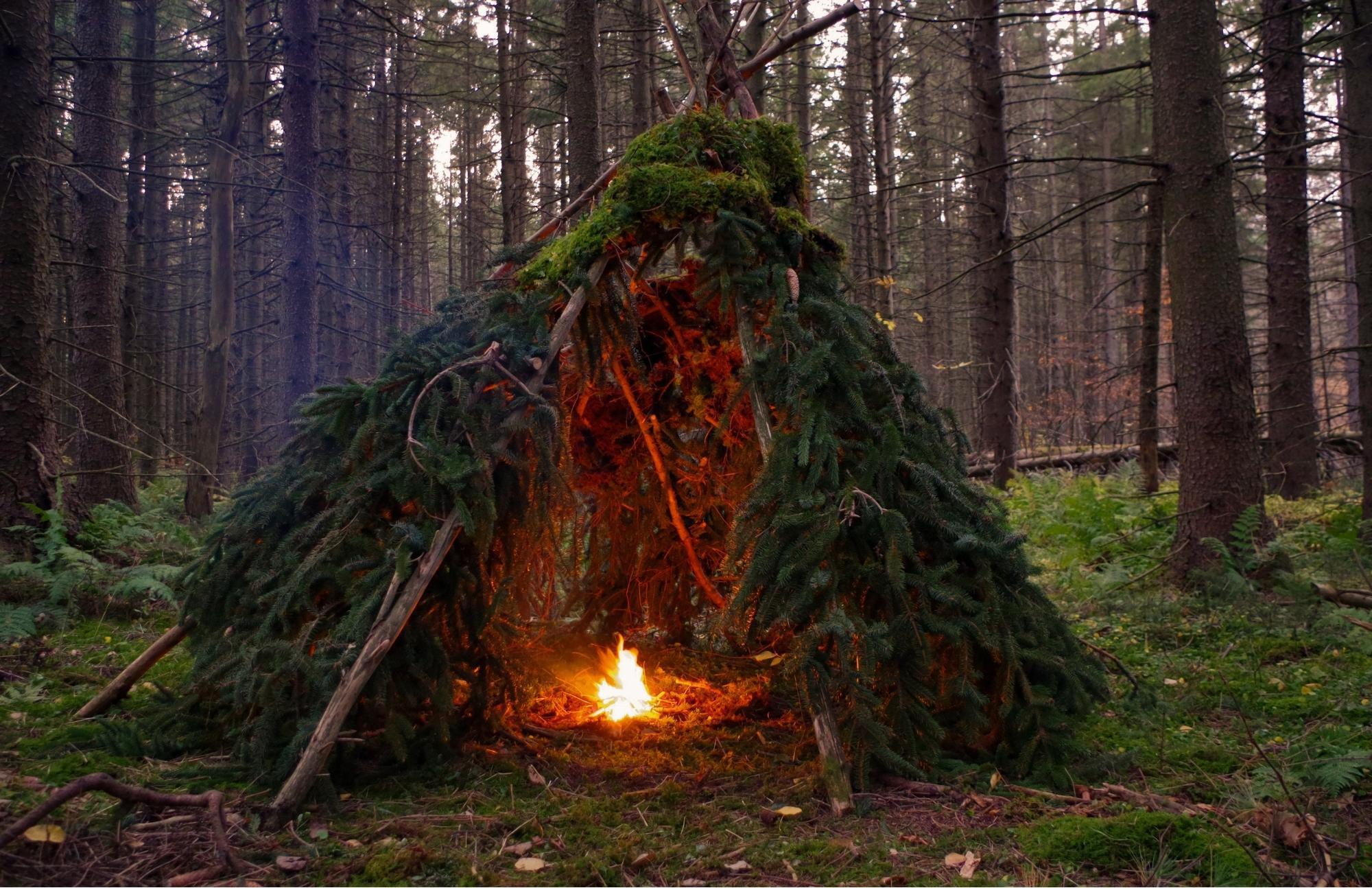
68
Photo by James Mahan
Cold and Injured
By Patrick Norton
Right around this time of year outdoorsmen of all types are heading out into the wilderness to partake in their favorite winter sports. Be it hunting, skiing, snowboarding, snowshoeing or snowmobiling, the risk of suffering an injury in the cold greatly increases in the late fall, summer and early spring months. Bear in mind that snow and freezing temperatures are not required for one to experience a cold-related emergency. Even in warmer climates, especially in places such as the desert or at sea, where drastic temperature drops are common at night or during and after a submersion incident, hypothermia, frostbite or a non-freezing cold injury can occur. This piece will serve to familiarize the reader with the signs, symptoms and treatments of these common, and sometimes deadly, winter ailments. It will also show the importance of preparedness and proper training in recognizing and treating them early.
First, it is crucial to have a baseline understanding of the physiology of heat production and heat loss in the human body. There are three ways the body can produce heat on its own: resting metabolism, exercise and shivering. When the body is given energy as food, chemical reactions take place to convert energy to power the mechanisms that keep it alive and allow it to work. One of these energy conversions is turning the potential energy in food to heat energy. This resting metabolic rate will increase a bit in cold conditions, but it does not provide enough heat to sustain life in winter weather. The second form of heat production is physical exercise. Exercise is a great heat producer, whether through short bursts of intense exercise or constant, moderate movement. Exercise does have some constraints and concerns, however, that need to be considered. Athletic ability, conditioning, stamina and endurance as well as availability of energy in the form of food and water are limitations for exercise. Sweat production is another concern associated with an injury in a cold environment. These concerns highlight the importance of physical fitness, acclimatization, proper nutrition and hydration, effective winter clothing, layering and activity regulation. All will be addressed later.
The last physiological method of heat production is shivering. Yes, shivering is a mechanism for the body to create heat, not just a symptom of hypothermia. Essentially, shivering is a response to a

 Norton talks recognition, prevention and treatment of common cold-weather medical emergencies.
Norton talks recognition, prevention and treatment of common cold-weather medical emergencies.
drop in core body temperature. This response creates heat at a rate of approximately five times that of a resting metabolism. Again, this form of heat production is fed by food, water and oxygen. Shivering also decreases fine motor function, hindering the victim’s ability to perform essential tasks required to keep warm in the first place. This will bring us to the importance of preparedness and prevention of heat loss, but first a crash course on the forms of heat loss is in order.
There are four types of heat loss that occur in cold environments: conduction, convection, radiation and evaporation. Conduction is heat transfer through direct contact. For example, body heat transferring to the rock one may be sitting on. Convection can be thought of as heat loss due to air passing over the patient. Radiation is the indirect transfer of heat from a hot to a cold object. Heat is also lost through evaporation, either by sweating or by breathing. To maintain an adequate body temperature, it is imperative that the backwoodsman mitigate heat loss from all three forms of heat transfer and evaporation. When this is combined with proper nutrition, hydration and activity regulation, the chances of suffering a cold-related injury will greatly decrease.
The most important thing to do to fight hypothermia, and other cold-related injuries, is to establish preventative measures to ensure it does not happen in the first place. In order to be prepared, one must carry the proper gear and supplies, research the area’s conditions, acclimate to the environment and make a concrete plan for the trip and for possible emergencies. Also, before the wilderness enthusiast even leaves the house, he must train! This training includes learning effective and efficient wilderness living, survival and medical skills such as: camping, sheltering, fire building, camp cooking skills, proper wilderness layering, smart activity regulation and wilderness first aid (WFA). All too often, many people go out thinking they know exactly what to do because they have either been hunting or snowmobiling for so long that they automatically have gained survival or medical skills through osmosis, or they have watched
enough hours of YouTube to know it all. This is not the case! Assume you will not rise to the occasion when an emergency happens. In general, these are the people that get into critical situations or die whether due to cold injuries or something else. Take the time to learn the proper skills. Teaching all of these skills are beyond the scope of this piece but learning to make an effective shelter and fire quickly, efficiently, and safely is a good place to start. Also learn to properly layer and regulate exercise.
The most effective and easy way to layer is the modular, three-layer system. This includes a formfitting, moisture-wicking base layer of wool or synthetic material. Wool is preferred in the author’s opinion because it does not become stinky due to sweating. The second piece of this system is an insulating layer, also of wool or synthetic material. Down material is acceptable only in dry environments. This layer should not be too tight; the idea is to hold heat in the negative airspace of the fabric. The final layer is a breathable, waterproof shell. Gore-Tex is preferred, but there are other materials that do the trick as well. The purpose of this layer is to protect the wearer from wind and water,

while allowing the other layers to breathe and expel any moisture that has built up. Do not forget to also wear warm headwear, footwear and handwear.
Do not overtighten footwear as this can inhibit circulation to the feet and toes. The following is a simple example of how to employ this modular system along with proper exercise management. Imagine the wearer of this three-layer system is at the bottom of a fairly steep slope. The next step in the expedition is to get to the top. The wearer is fairly certain that he will create heat through the exercise required to get there, so he sheds his middle, insulating layer. He begins to climb but maintains a moderate level of exertion using a steady pace, following a switchback pattern up the hill. Doing this, rather than forging straight up the hill as fast as he can. Option one will mitigate sweat production, which could freeze or increase his chances of hypothermia or another cold-related injury. If the hill climb is quite long, he can take frequent rests as he begins to feel himself start to sweat or overexert. Certainly, by the time he gets to the top, he will want to take a good rest, eventually donning the insulating layer again before cooling off too much. This is an easy-to-follow example, but it
is important to be strategic and diligent, no matter how complex the scenario.

Finishing the topic of prevention, adequately fueling the body is required to perform exercise, simple tasks and to power the metabolic heat production mechanisms addressed earlier in this article. Make sure food is consumed regularly, in proper amounts and according to the intensity of activity. Remember, food intake should be increased in colder environments, whether intense exercise is involved or not. Carbohydrates are converted into kinetic and heat energy very quickly, which is likened to tinder in fire-building. Fats and proteins will provide more sustained energy. Lastly, proper hydration is of the utmost importance to prevent not only a heat-related injury, but a cold one as well. It allows for adequate perfusion to supply oxygen and nutrients to the cells and to circulate warm blood to the vital organs and extremities. Pre-hydrate before an activity and hydrate often during the activity. Make sure to have electrolytes available so the body can absorb the water it is supplied. Under normal circumstances, food provides the body with enough electrolytes, but under strenuous activity, the rule of thumb is one liter of electrolyte replacement for every two liters of regular water.
If these measures fail, cold injuries may ensue. There are different types of cold-related injuries, and each has different levels of severity. A cold injury may also occur in conjunction with other injuries. Therefore, in a wilderness setting, the primary patient assessment not only includes airway, breathing and circulation assessment and intervention, but spinal disability and environmental measures as well. It is recommended to take a WFA course, at minimum, to learn to properly carry out a patient assessment, which every patient deserves. The first type of cold injury is hypothermia.
The key to treating hypothermia is to recognize the signs and symptoms early and treat it immediately. The signs and symptoms of hypothermia vary depending on the severity of the condition. These include shivering, goosebumps, loss of fine motor functions, stiff extremities,
clumsiness, poor decision making and confusion. When these symptoms increase and the patient will begin to become more uncoordinated, beginning to include an altered gait and falling. They will often show signs of obvious mental status changes, at this stage, the patient should be considered to have moderate hypothermia. These symptoms are often called “the umbles” or stumbles, fumbles, and mumbles. To treat mild and moderate hypothermia, dry the patient, dress him/her in warm clothing, move him/her to a warmer location protected from wind and encourage movement if
possible. In moderate cases, the patient may need to be put in a sleeping bag with an insulating pad between them and the ground. The patient should be given warm drinks with plenty of sugar if swallowing is possible. The caregiver should also put hot, but not scalding, water bottles or chemical heat packs on critical places such as the torso, back, armpits and groin with a layer of clothing in between. Once the patient is warmed, he may begin to have solid food such as candy or energy bars, progressing to full meals with fats and proteins. Fires with a reflector wall or space blanket will also

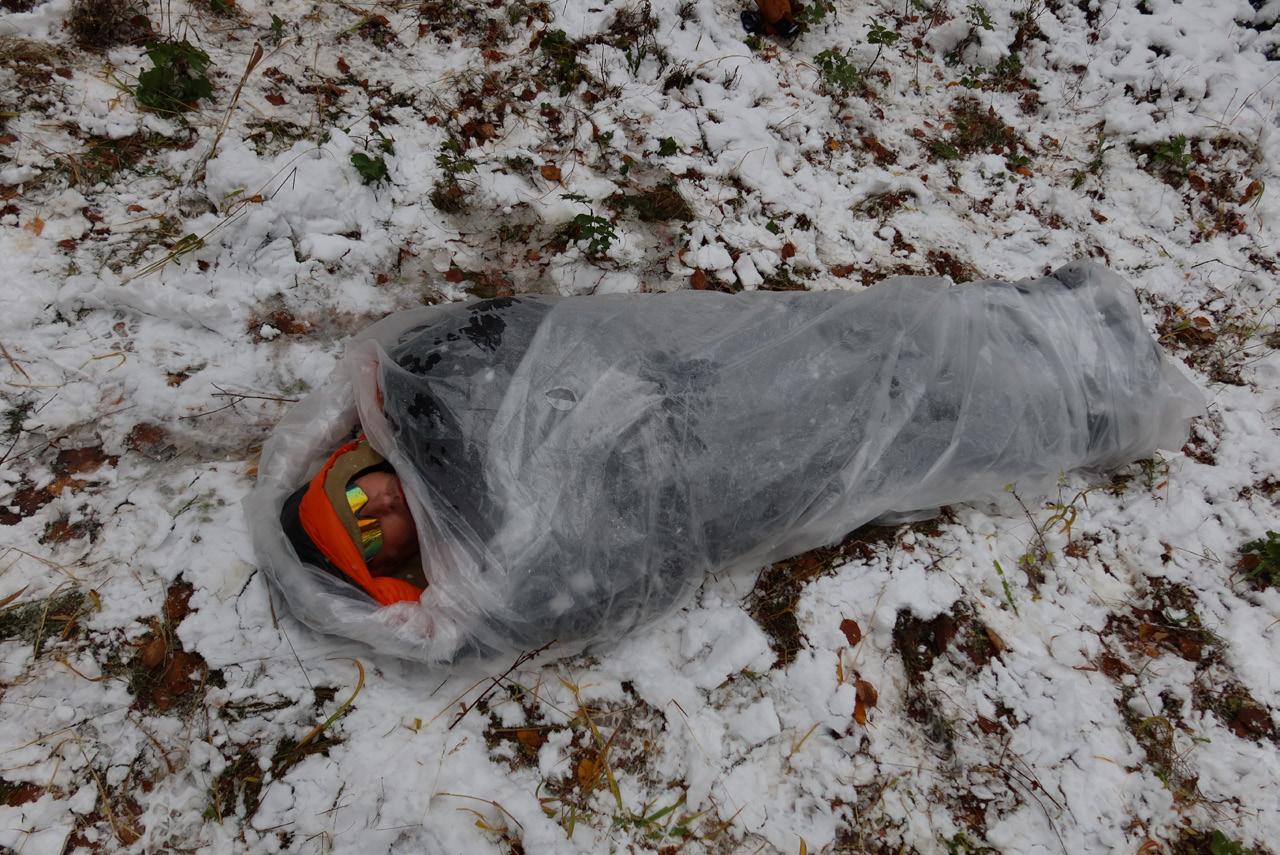
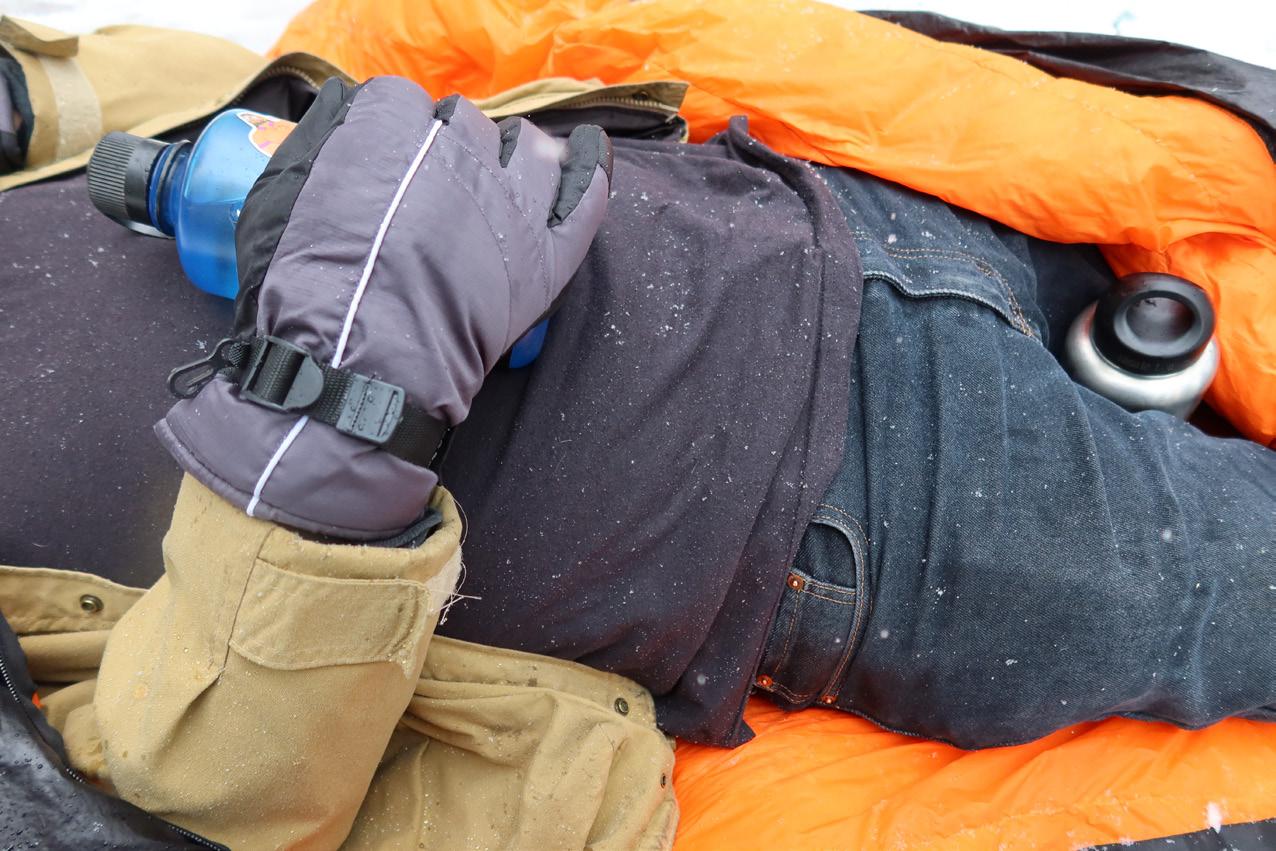
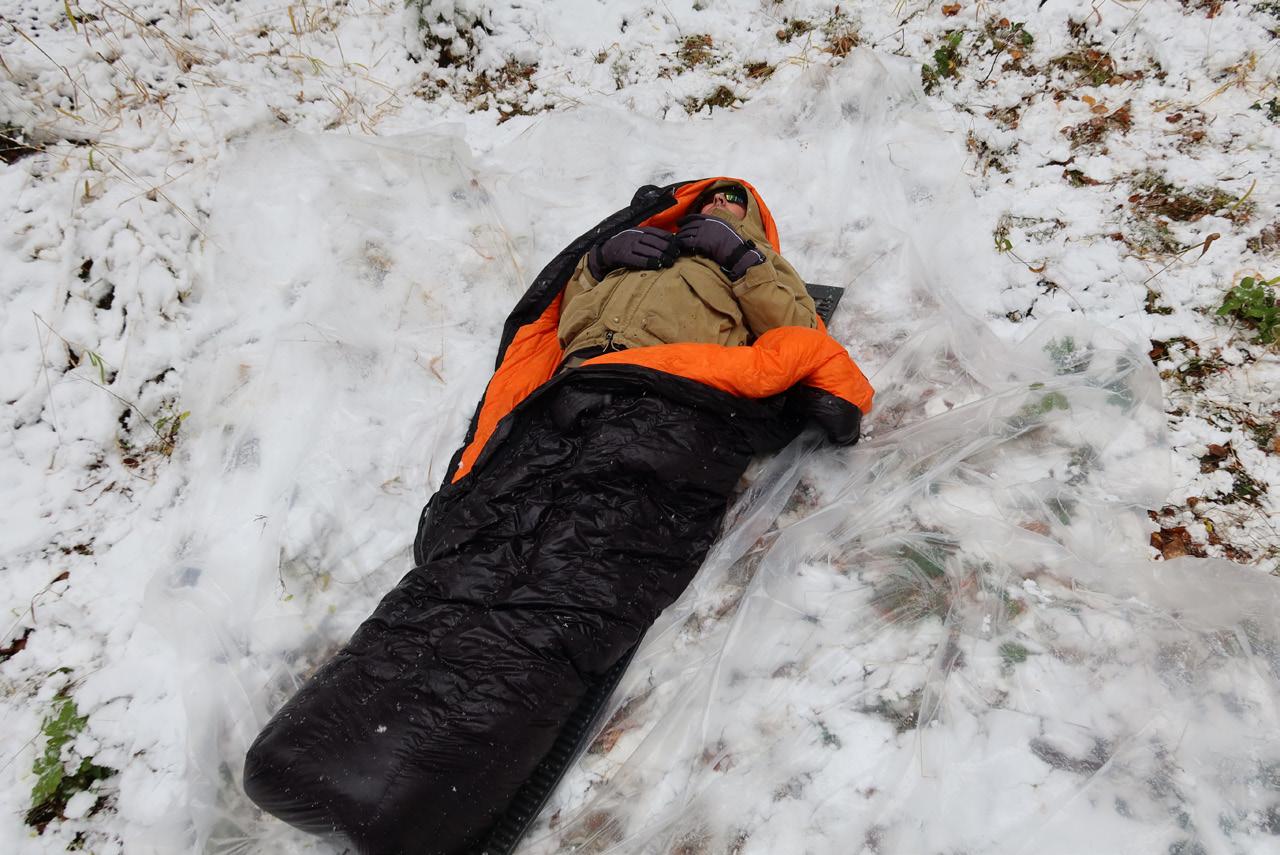
72
Photo by Patrick Norton: Place heat packs or hot water bottles in critical areas, being sure they are not scalding.
Photo by Patrick Norton: Here is an example of one of many simple modifications to the hypo-burrito. Roll a pliable stick in the head section of the wrap, bending and tucking the stick ends into the wrap to create a convenient hood.
Photo by Patrick Norton: Safely and properly position the patient in a sleeping bag on an insulating pad with occlusive sheeting underneath.
Photo by Patrick Norton: Zip up the sleeping bag or tuck in the blankets and wrap the sheeting around the patient to complete packaging.
help rewarm the patient. Most times, rewarming a mildly hypothermic patient can be done in the field and the patient may continue the trip once ready. In moderate cases, this becomes more difficult but can still be possible. Keep in mind, the rewarming process may take a long time and may not always succeed in the field. Be persistent and do not allow for any more heat loss.
If hypothermia progresses, the patient may stop shivering due to energy depletion and show a profound decrease in mental status, muscle rigidity and a lowered heart and respiratory rate. This is severe hypothermia, a life-threatening condition. The patient likely will not be able to swallow, so giving warm drinks and food will not be possible. In cases of moderate or severe hypothermia, the patient should be put in a hypothermia wrap (hypo-wrap) or “hypo-burrito”. Many useful modifications can be made to improve the hypo-wrap and can be viewed online or learned in a wilderness medicine course. However, the basic principles of the hypo-wrap remain the same in all variations. Begin by heating water bottles or activating chemical heat packs. Lay the patient down on a large, waterproof sheet, such as a plastic tarp or drop cloth. Put the patient in at least one sleeping bag or wrap in blankets with an insulating pad underneath. Place the bottles or heat packs in the critical areas mentioned above, including by the feet. Finally, wrap the patient in the waterproof sheeting by tucking the edges under the patient to keep warmth inside the wrap. A cloth or scarf may be placed over the patient’s mouth to prevent evaporative heat loss.

When handling this patient, be very gentle so as not to cause cold blood to circulate to the heart. This may cause a life-threatening heart arrhythmia. Keep in mind that the patient’s pulse and respiratory rate may be difficult to detect, so go slow with the assessment. If they are absent, CPR may be performed. However, when in doubt, give only rescue breaths. Due to the preserving nature of cold, the patient may appear deceased, but given in-hospital warming and resuscitation care, many patients do survive. Remember, “the patient is not dead until he is warm and dead.” In most cases of mild or moderate hypothermia, evacuation is generally not necessary, and the patient can be rewarmed and continue activity as long as mental
status returns to normal. With severe hypothermia and some cases of moderate hypothermia, the patient should be quickly and gently evacuated to a higher level of care.
Frostbite is a condition in which tissue, most commonly that of the fingers, toes, ears, nose and cheeks, freezes locally. The fluids between the cells of the tissues freeze, causing damage from the friction between the ice crystals and constriction of blood flow due to blood clots in the blood vessels of the affected area. Frostbite is categorized in much the same way that burns are. Superficial frostbite, also known as frostnip, affects the outer layer of skin, causing it to appear red at first, then grey or white and waxy. The patient may experience numbness, tingling or pain. Partial-thickness frostbite affects the tissues underneath the outer most layer. The signs and symptoms for partial-thickness frostbite are much the same as for superficial frostbite, but the outer tissues may feel hard and frozen, while the underlying tissues may be softer. Full-thickness frostbite, occurring deeper into the muscle tissue of the patient, will also have similar signs and symptoms to those of superficial and partial-thickness frostbite, but the outer and underlying tissues will feel hard and frozen. It is
difficult to determine the severity of frostbite until after it is rewarmed, but the presence of blisters within 24 to 48 hours of rewarming may indicate partial-thickness, while the absence of blisters may indicate full-thickness frostbite. The treatment of frostbite is mostly the same across the board when it comes to severity.
The patient should be brought into a warmer place, and wet clothes and jewelry should be removed. The affected area may be rewarmed if there is no chance of refreezing. This can be done by skin-to-skin contact or sticking fingers in the armpits. However, rubbing is not a good idea as this can cause more damage. Do not expose the affected area to flame or rub snow on it. Ideally, the injured area should be rewarmed by submersion in 99°F102°F water. This is best done in a hospital setting since a constant warm water supply is required. Under-thawing can result in further damaged tissue. A flush of pink indicates that rewarming is taking place and blisters may form. This process will be very painful. Pain management measures, such as Ibuprofen are recommended here. After the area is rewarmed, use extreme care when handling the area, placing padding between fingers and toes and wrapping and protecting the affected part. Encourage the patient not to use the injured body part.
Quickly evacuate any person with frostbite, being careful with the injured area. It is imperative to avoid rewarming if the chance of refreezing is high during evacuation. Preventative measures for frostbite are similar to those of hypothermia, with the addition of being especially careful to cover at-risk body parts and not touching frozen, metal objects. Frostbite is generally not life-threatening but can lead to loss of function and even amputation. Remember, it is easier and safer to stay warm than to treat a cold injury.
The final injury that will be addressed is a non-freezing cold injury, commonly known as trench foot. Trench foot is caused by prolonged exposure, usually in the feet, to cold, wet conditions, resulting in lack of blood, oxygen and nutrients to the extremity. The symptoms of trench foot include swollen, cold, painful, white or gray, shiny or mottled feet. Pain, numbness, or tingling may occur. Capillary refill may be slowed. This can be tested by pressing fingers on the affected part and watching the color return to the area. This should take less
than two seconds. In severe cases, blisters or gangrene and long-term disability may develop, as well as the need for amputation. If the patient experiences any numbness or tingling, be suspicious of developing trench foot. Treatment of trench foot involves rewarming the affected area at room temperature, elevating the affected body part and encouraging bed rest to avoid further trauma. Avoid trench foot by being very diligent in keeping feet dry and warm. It is important to dry and change socks frequently, avoid overtightening footwear, sleep with warm, dry feet and pay special attention to the needs of feet, examining and massaging them at regular intervals. Sometimes getting wet, cold feet is unavoidable, but care should be taken to keep them as dry as possible by using terrain to your advantage and the proper equipment, including plenty of thick wool socks and galoshes or waterproof boots with gaiters. In general, non-freezing cold injuries do not require evacuation.
Although not exhaustive, this article will give the reader an informative introduction to understanding, recognizing and treating some of the more common cold-related injuries that may occur during outings into the wilderness. The most important takeaway should be that preparedness and prevention are the preferred and safest methods for addressing these conditions. Proper research and training are encouraged before heading out into the wild. The author believes that it behooves everyone who works or plays outdoors to take a two-day wilderness first aid course to prepare for their next trip. Visit artossurvival.com for more details on WFA and survival courses in Northwest Montana or find an instructor near you. Stay warm out there!

74
Photo by Noelle Otto
When a dog is not man’s best friend
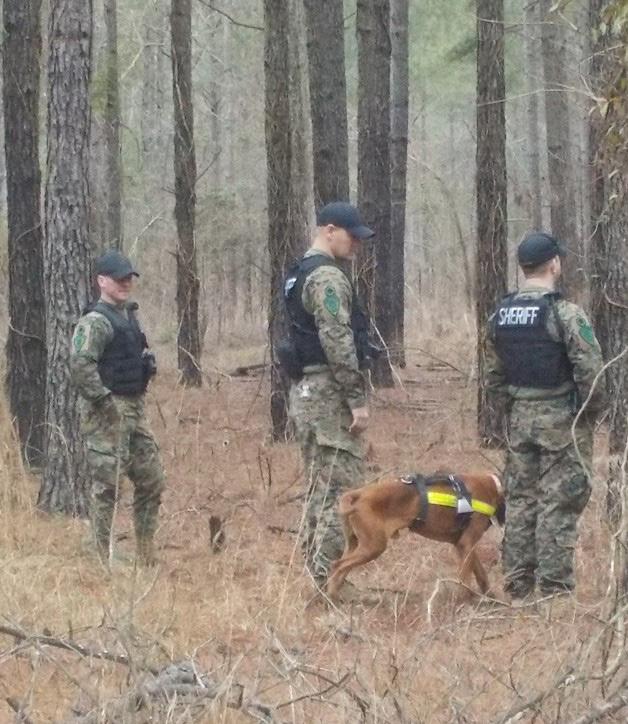
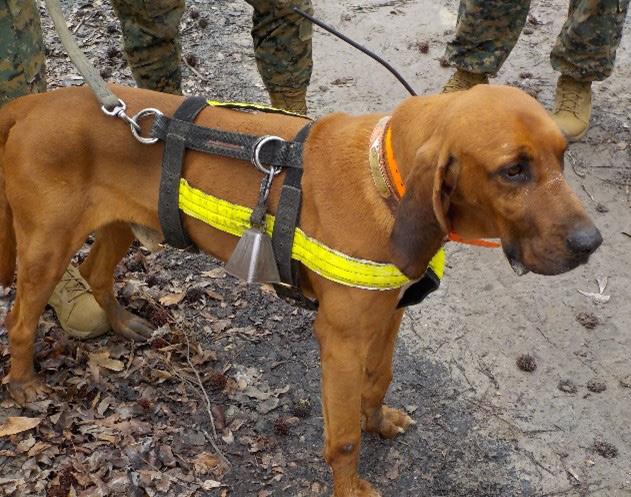
Most of us think of dogs as our companions. Friends that will love us unconditionally, so long as we feed them, exercise them and love them. But for some people a dog can be an enemy. One that can attack and even kill, one that can discover hidden or illegal substances or one that can smell human scent. In this article I will look at dogs that use their noses to scent humans and to track them down.
The most common and best known of the human tracking dog breeds is the bloodhound. Bloodhounds are the ultimate scenting dogs and there are packs which are used for tracking all over the world. Their origins date back to the Middle Ages in Europe, where they were originally used for hunting deer and wild boar. It is impossible for us to really comprehend just how good these dogs are at scenting and tracking humans. They can detect human scent days after a human has passed, they can scent over water and they can do this over long distances. And, here is the thing, they are tenacious and perfectly designed for scenting and ‘trailing’ their target. They are so impressive at doing this that in some places in the world their results can be presented in court and are admissible as evidence.
Everything about the dog is designed for scenting, including its face, ears, shortish legs and long strong neck. However, what makes a bloodhound so exceptional is its nose or rather the olfactory (scenting) area inside of the nose. In humans, this area is about the size of a postage stamp, in bloodhounds it is the size of a handkerchief. Physiologically, the number of scenting cells inside the bloodhound’s nose is about 300 million, compared to a human’s which is about 5 million. In real terms, means that this breed of dog,

under optimal conditions, only needs to detect one or two human cells to lock on. Even more impressive is that these dogs can scent discriminate and lock onto the target scent once it is known by the dog.
Humans shed about 40,000 skin cells per minute, approximately. The longer a person stands in one place, the stronger the scent becomes. It is this skin shedding that is the principal method of tracking that the bloodhound uses. The record for picking up and tracking a scent is held by a dog that found a family dead 330 hours after going missing in Oregon. That is nearly 14 days later!
Most of our knowledge, or preconceptions, about tracking/ trailing dogs comes from Hollywood, from such films as Cool Hand Luke, The Shawshank Redemption and others that feature these dogs sometimes give the impression that they are easy to fool. In reality, they are not. In experiments, trained and experienced dogs tracked human subjects successfully 96% of the time. From our armchairs it is easy to think that we can distract these dogs. We may think that we can use peppers or other chemicals to disrupt their noses. We can’t, and a dog will simply work through them. We may think that we can use water to mess and disrupt our scent, but this barely slows the dogs down.
Joel Lambert, ex U.S. Navy SEAL and star of Manhunt/Lone Target, and I recently had the experience of being chased by bloodhounds from a police bloodhound unit in the USA. This episode of Manhunt/Lone Target was the last to be filmed in season two and it was the one that we most wanted to win. It was also the one that caused us the most concern. We strategized and planned during the preceding weeks and, like most people, made some assumptions that proved to be misguided and, in some cases, and downright wrong. Now, I have been hunted by dogs before during a number of escape and evasion exercises, both in the UK and in Germany, and Joel had been up against dogs during Season One in Poland, but they were other breeds. These were mainly German shepherd dogs, which are not dedicated scenting dogs and easier to evade than bloodhounds. Going up against these dogs was not only going to be a challenge if we were to be successful, it would also require a sound strategy and a certain degree of luck. The details of how we did will remain a secret, but I can reveal some of the considerations that we took into account and some general guidance.
I should state at this point that the police bloodhound unit we were up against do not come up against soldiers with training in escape and evasion. We were not criminals running for our lives, but professional ex-soldiers who have served with

elite units in the U.S.A. and UK, and have had some excellent training in Survival, Escape, Resistance/Recovery, and Evasion/ Extrication (SERE). Some of the emotions and tensions that a person on the run exude are easily detectible by scenting dogs. We on the other hand, were cool and calculating. We were not intimidated by the dogs, and we had pre-formed strategies that we could implement depending on the environment and the opportunity.
So, here are a number of things to take into consideration and some general pointers:

1. Bloodhounds are single minded once they pick up your scent and can pick up the scent many days afterward.
2. They can scent through shallow water through which you can wade, but have difficulty in water in which you can swim in.
3. All a police bloodhound unit needs is an accurate location of where you were. They do not, as is commonly believed, require an article of clothing or object to obtain your scent.
4. They are not disrupted by pepper, pepper sprays, CS gas or other chemicals and frankly if you are on the run, you are unlikely to have access to these anyways. All these devices do is confirm to the handler that you were there. Do not waste time. Time and distance are your friends when evading dogs.
5. Trailing teams do not need to rest at night. They can bring in relief teams to work through the night and operate shift patterns as the dogs are usually part of a pack. This means that you cannot afford to rest. Unlike the tracking teams, you will not be able to use light to guide you through rough terrain.
6. These dogs have incredible endurance, and some have even died from exhaustion while scenting.
7. If you cannot evade the dog, then target the handler. I am not suggesting taking the handler out, as mostly the dog is usually only one part of a professional tracking team and, unless you are experienced in laying and initiating an ambush, it is likely that this will get you shot or at the very least re-captured. A good team will have an experienced handler who can interpret the
dog and also have a flanking armed security team for protection.
8. Target the handler by exhaustion. Use the terrain and the vegetation to slow down the dog and handler. When these teams move through open ground trailing, they are very fast, and the handlers are usually pretty fit.
9. The dogs usually work in isolation with relief dog and tracking teams being brought in as required.

10. Contrary to popular belief, they usually do not bark when trailing. However, the handlers will often be heard encouraging the dog. When this happens, you need to do something quickly as they will be on you quickly if you continue without taking evasive or deceptive actions.
11. Using places where lots of humans have congregated will likely slow down the dog, but with a good dog, it will only be a minor delay. Your scent is unique, and the dog can discern your scent from that of others. However, if you are being tracked by a younger or less experienced dog, you have about a 50/50 chance of evading successfully.
12. When moving over ground, use terrain that has little or no bacteria within it. Sand, concrete, and rocks all make it more difficult for the dog, but remember it will work through this eventually.
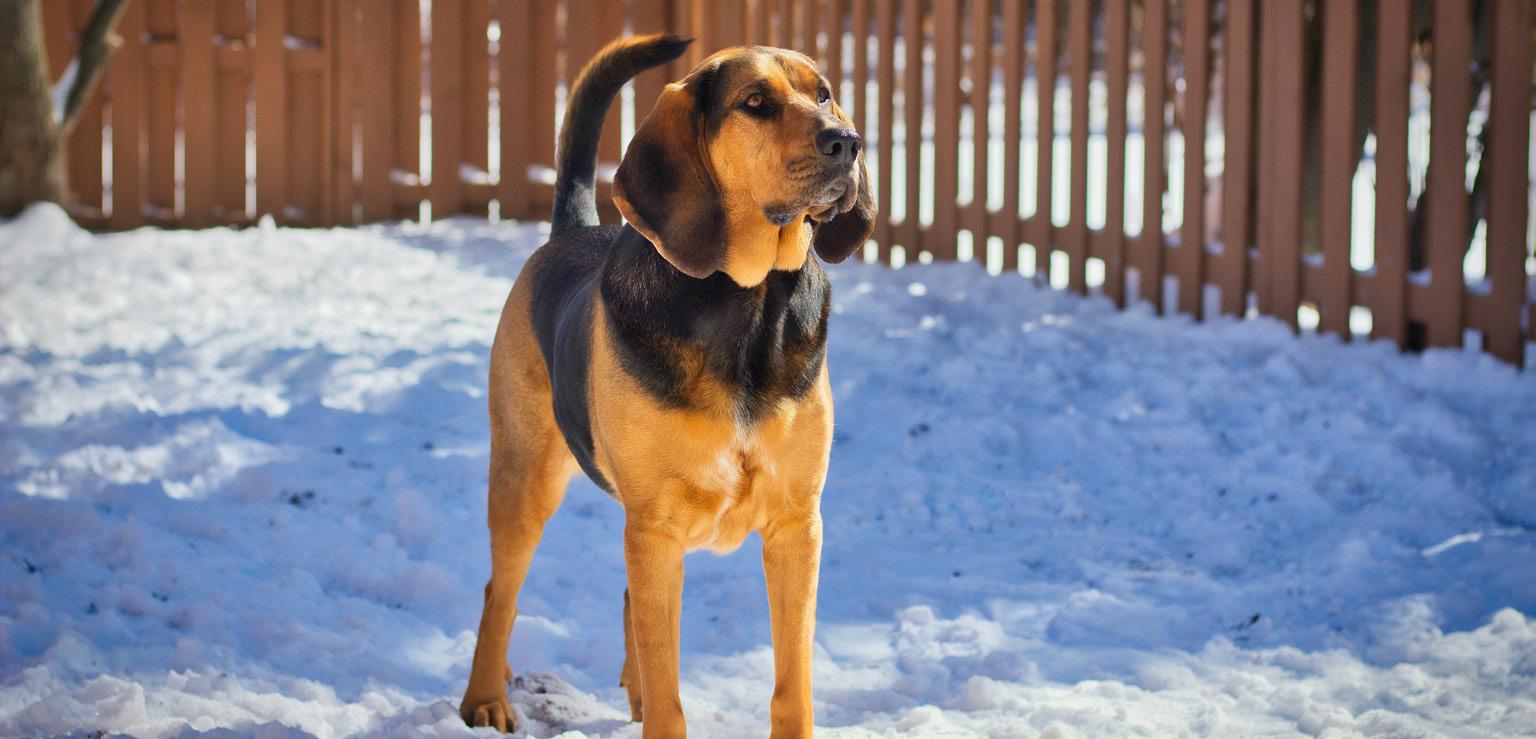
13. Use deep water to swim through. Yes, the handlers will know where you have entered, but now they have to figure out where you went and they will have to scan two sides of a watercourse, which all takes up time. The more difficult you can make this the better.
14. Make the handler doubt the dog. This works best with an inexperienced dog, handler or both. Where time is on your side, put in multiple deceptions.
15. Bloodhounds have been known to scent their quarry even when in a vehicle. This can be used to gain distance and time to be used to your advantage later.
Be under no illusions, these dogs are hard to evade and frankly bloodhound units are very well trained as are the dogs. A certain amount of luck goes a long way. There are some techniques that have not been discussed and will remain in the domain of the elite units, but generally speaking and if you consider the measures above, you will give yourself the best chance of being successful.
Photo by Koolshooters
Photo by Gary Smith
Most people don’t know much about wild plants --- much less about the wild plants that they call “weeds” --- and just ignore them. The weekend survivalist assumes that all they need are guns, shelter and a water source. My partner in grime Mykel Hawke and I knew that a book was needed which details many edible plants with hundreds of photos and every warning included that we could think of combined into the study of survival.
Wild plants that are edible to humans tend to contain more beneficial nutrients like vitamins and minerals than cultivated foods. All cultivated foods originated as wild plants, and over the long history of agriculture. Likely starting around 12,000 years ago, humans have saved seeds and hybridized plants to genetically select larger, easy-to-grow varieties. Such plants make for greater crop yields but tend to contain fewer nutrients than their wild counterparts. Add to that the fact that most cultivated food sold in stores and restaurants is produced on soil so depleted of minerals that they require artificial fertilization, unless grown organically, this leaves them even more lacking in nutrition than those wild weeds growing around the home or in that empty unused vacant lot down the road. I cannot tell you whether or not it’s legal to forage for food away from your own home, especially on someone’s private property, or in the woods, but in that famine, doomsday or survival situation legality would be the least of your worries.
According to Katrina Blair, in her book The Wild Wisdom of Weeds: 13 Essential Plants for Human Survival, “Wild edible foods tend to grow within biodiverse communities, enabling them to garner nutrients from the richer soil conditions supported by this biodiversity. Additionally, fresh wild foods can be eaten on the day of harvest, whereas cultivated foods often lose nutrients during transportation and storage.”
When you build a garden, you are wise to pull up other plants that sprout up around your cultivated species, but you probably don’t know that much of the plants referred to as “weeds” are actually species of wild food plants that were purposely bred by our ancestors to be invasive and noxious. In some places the majority of the “weeds” that sprout up wherever you turn the soil for gardening and landscaping

either has edible and nutritious parts, medicinal uses, or both. Yes, I said most of those weeds! Learn what they are and leave room in your garden for some wild food like the nutritious dandelion, wild spinach (Lamb’s Quarters), dock, burdock, milkweed, minor’s lettuce, fireweed, chickweed (your chickens, ducks, geese, turkeys, etc. will love it), peppergrass, and many other species. In fact, every corner of America and every region of the world has wild food of some kind if you know what to look for and how to use it.

Know your plant species! Positive identification is the Rule #1 priority in my opinion. Rule #2 is do not try to eat something that your tastebuds find disgusting. If your reaction to chewing something is to spit it out it will be wise to spit it out. Particularly if there’s any question of its edibility and especially if it is a survival situation when you are already very hungry and maybe already very weak so anything that could cause you to get sick could be the very last thing that you eat.
There are many species of plants that are edible in varying degrees. There are choice (the best)
edibles that include delicious berries, starchy roots and tubers, ground up seeds removed of chaff, stalks, leaves and gourds that can be boiled and eaten as is or in a stew and there is also what I consider “famine food” wild edibles which have varying degrees of palatability and practicality. Beware, there can be toxic lookalikes to edible species. Also, be sure of which parts of a species are edible, which are not, and how to properly prepare each when necessary. When researching, I have seen bad information being posted online. Always verify information on the edibility of anything with multiple sources. Especially look for accredited experts like Green Deane of eattheweeds.com, myself and a variety of books available.
Rule #3 is too much traffic near potential wild edibles is contaminating to them with the heavy metals and chemicals of engine exhaust, oil, gas, and rubber. Downhill embankments from roads are not safe either because of the runoffs from rain carrying those same heavy metals and chemicals downhill. For this reason, look uphill from roads and as far away from the curb as possible, depending on how

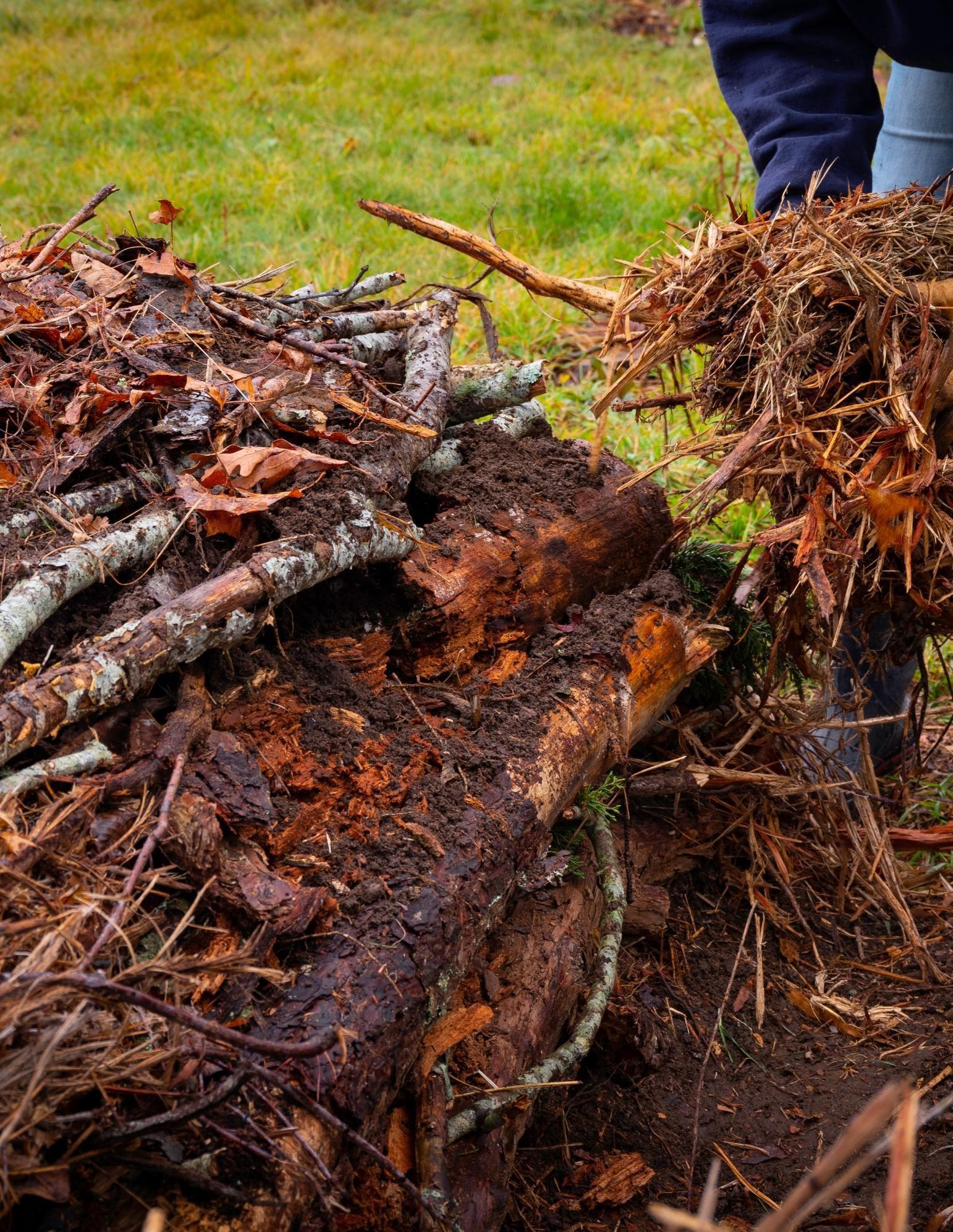 Photo by Sanghwan Kim
Photo by Sanghwan Kim
HugelKultur
Using Hugelkultur for Flourishing Gardens and Effective Water Conservation.
By Sam Coffman

Hugelkultur is a concept that has probably been around for at least centuries if not millennia. The word “hugel” means “hill” in German, and “kultur” means, well… culture. The idea is pretty simple. Stack a lot of rotten logs and other natural plant debris into a mound and cover it with dirt. This is a little oversimplified however, and I would like to explain how to use and modify this concept to produce excellent garden yields with a fraction of the water used in a flat-bed style garden watered from above.
My primary reason for first using hugelkultur in my own gardening was primarily to be able to conserve water in the very hot and dry drought years in central Texas. I found it to be almost as effective as a closed wicking bed in water conservation and an amazing way to create nutrient-dense soils that can last for years without needing much extra work once they are made.
While water conservation may not be an issue depending on where you live, hugelkultur can still be a way to get better long-term high yields from your garden for several years without as much work as raised beds and other closed systems. This is because of the way in which nutrient cycling takes place in a well-built hugelkultur bed.
In regard to where you live and whether hugelkultur will work for you, there are a few considerations. First, a hugelkultur bed works best the first season you plant in it if you prepare it at least a few months ahead of time. This is because it takes a little time for the bed to both settle and “cure” as well as the nutrient cycling to be underway by the time you plant.
Another consideration is wind. If you live in an area that has a lot of wind during your growing season, you may want to build a wind block to prevent erosion of your hugelkultur garden topsoil. The same erosion issue is true of heavy rains if they happen before your crops have grown enough to give you a root system.
Speaking of roots, the first year or two of a hugelkultur bed works better for above-ground harvests than root crops. This is because of the branches and plant debris deeper under the topsoil, such as tubers and roots, will get stuck in. This will make it harder to harvest without tearing up portions of the bed.
So aside from the excellent water conservation and nutrient cycling that one can get from a hugelkultur bed, what are some other advantages? One is that it is easier to weed and harvest from a hilly garden bed, and if it is built correctly and one does not have to worry about walking on it – especially if one is trying to maintain a no-till garden. Another is that from year to year, if you build it correctly, you can continue to plant without having to worry as much about feeding the soil from the top. Finally, you can not only get a better effect from top-down drip irrigation, but you can also automate an underground watering system if you want to set up your hugelkultur bed similar to a wicking bed.

To make a hugelkultur bed there are several variations, but I will discuss my own personal tips that have worked best for me over the years.
First, although you can place your branches and natural debris directly on top of the ground, I prefer to dig a trench. My reason for this is that it gives more depth to use, and also that it integrates the soil health better into the earth around the bed, making for a better garden space even years later if you decide to unearth the mound and plant on flat ground. By adding a trench, the whole bed becomes some sort of slow nutrient feed to not just your garden on top of the mound, but to the surrounding area including the sub-surface. Additionally, a trenched version will retain water better and not dry out. Building on top of the ground can also be more of an attraction to rodents who might start making their homes in the base logs of your mound. If you are trenched, there is more dirt
and protection. Finally, if you dig a trench, you will be able to re-use that dirt on the bottom layers of your mound. Or, if it is already really good soil, it can make up the top layers of dirt too.
I start with a trench that is anywhere from eight inches to one foot deep, about five feet wide and 10-15 feet long. Since I spent the last 15 years in the hill country of Texas, it wasn’t easy to dig very deep because of all the limestone. It is fine if you have to dig around rocks a little and your trench is not completely uniform in shape. Bear in mind that your mound can be anywhere from a few feet to even as high as six or seven feet. The higher you are making the mound, the steeper it will be, given the same width. Therefore, a higher mound usually needs to have a wider base. Note that having a high mound that is protected from wind and water erosion until fully planted can create different microclimates that produce more of a polyculture and healthy garden. In fact, a high mound itself can serve as a good wind block for other parts of the garden.
Now it is time to layer your material. Starting from the base of your mound, in your trench, you generally want to put the largest pieces of wood that you have. These will take the longest to break down and will hold water at the base. It is very important you are not using green wood for any of your hugelkulture. Green wood will take much longer to break down and could arguably rob the soil around it of nitrogen for some time while it slowly decomposes. Ideally you want wood that is not only dried, but at least partially rotted. The more it is already aged and rotting, the better. Again, place
84
Photo by Kristina Paukshtite
the thickest and largest pieces of rotting wood at the bottom and then slowly start to pile on thinner and smaller pieces of dried and/or rotting wood. Many folks say it is best to use hardwood logs at the bottom and then use softer woods as you layer up. If you don’t have the luxury of selecting different hardness’s of old wood you might have available, do not worry about it. If you don’t have any larger old wood at all, then use what you have. Bark, smaller branches and clippings that have had time to dry out, dry leaves, dried grass clippings are all fine, but the larger the wood pieces can be at the bottom, the better.
Have a hose and spray nozzle nearby to thoroughly spray down each of these layers as you go. Spray down the old logs filling your trench. You can even spray down the trench before you put the logs in. Spray down the smaller wood pieces after you layer them up at least a foot over the ground level. Walk on top of all the mound to help pack it down and spray it down some more. I like to make sure that at a minimum the lower 2/3 of the mound is soaking wet as that will retain the water best and help with decomposition over the next few months.
As I work my way up the mound and I am at least a foot or two (depending on how high I want my mound to be, at least 50% - 60% of the final height) over the level of the ground, I like to add layers of old straw and some of the “greens” in composting along with the small dead wood pieces. This can include everything from kitchen vegetable scraps that you would put into your compost pile, to partially or fully
composted matter from your compost pile. Burying vegetable scraps in or around a garden is sometimes referred to as “trench composting” and it works well if layered into the smaller wood pieces along with some dirt.

We have grown rabbits for food for years, and I like to use straw for their bedding. They like the straw as well because it’s easy to burrow in, nest with, etc. This rabbit straw mixed with rabbit manure has always made an excellent addition to my hügelkultur. Add layers of thin or small woody debris mixed with dirt on top of the mound at least a few feet over the ground level. This sort of “lasagna” layering approach to creating the above-ground layers of your mound allows a lot of potential nutrients to cycle inside the mound over the years.
Spray everything down again with water. This is now a great time to add in some earthworms. Worms are colony insects and do best if you put at least a handful together in each location throughout the length of the mound. Earthworms can be bought online or at your local garden store by the hundreds or thousands. They can even be grown at home. 2000 worms are more than enough for the dimension of the kind of mound I am discussing here. They will do best on top of the pre-wetted hay or dried grass clippings, then covered in dirt and with plenty of fresh kitchen scraps, rabbit poop, or other good worm food nearby. If you don’t have or want to put worms in the mound, that is fine too, but they will greatly speed up the decomposition and nutrient cycling of your hugelkultur mound. Whether you added worms or not, this is now the time to add about four to six inches of dirt across the whole mound. If possible, use the dirt you dug out from the initial trench for the mound. Spray it all down with water again until it is soaked through.
At this point the mound should be somewhere between two and three feet about the ground. This is where I like to mix up enough good topsoil to give myself at least three to four inches on top of the dirt we just put on to work with across the entire mound. Of course, you can buy ready-made topsoil, but it can be on the expensive side. If you are composting already and have some finished compost, this is a great time to use it and it can be part of a much
Photo by Julia Volk
less expensive DIY mix for basic topsoil. I usually mix roughly equal parts finished compost (humus – whether store bought or homemade), sand (and/ or perlite), and peat moss to make my topsoil. I also throw in several handfuls of pea gravel per wheelbarrow load of topsoil to help with drainage. The peat moss is more acidic in pH (which you may want, depending on what you are growing), and the pea gravel down in central Texas usually has limestone (alkaline) in it which helps balance out the pH a little.
On the topic of drainage, a hugelkultur mound will usually have very good drainage, but as I mentioned we want the whole mound to settle for a while first before planting in it. Ideally, we want not only good drainage downward, but also some wicking upward of moisture. As the mound settles, one should have a nice balance of moisture retention in the woody parts of the mound, while also having some wicking effect upward with the wood, sand and even pea gravel. At the same time, it should have good moisture retention in its topsoil with the peat
moss and compost, but also good drainage thanks to the sand and pea gravel.
Once you are ready to plant in your hügelkultur mound you can either plant seeds or seedlings. Using mulch material such as straw on top helps retain the moisture in the soil. If you are planting early in the year, it can also help protect your seeds or plants from colder temperatures. Adding in some logs, boards or even rocks or cinderblocks along the edges of the mound (where the mound hits level ground) will help mitigate any erosion, both while letting the mound settle as well as once it is planted. This also gives you some footing to more easily reach the top and upper sides of a mound for planting and harvesting.
You can water your hugelkultur garden from the top, with drip irrigation, or even use a root feeder or buried hose or PVC pipe in the same manner as a wicking bed. The logs, wood, and other plant material in the lower half of the mound will retain moisture for much longer than the upper soil and will both water and nourish your plants’ roots.
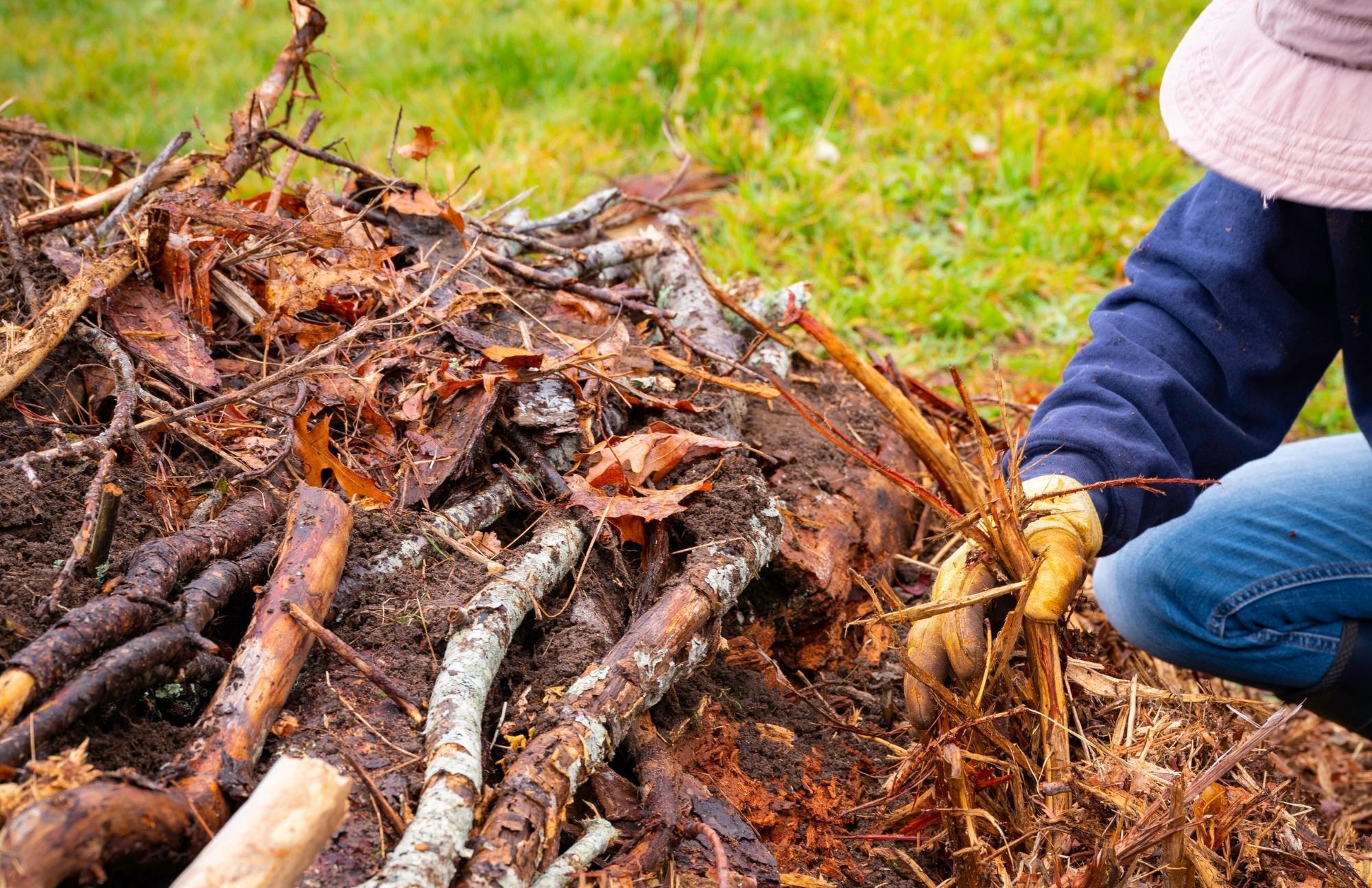 Photo by Sanghwan Kim
Photo by Sanghwan Kim

READERS CHOICE

The Poncho
A Story of Grit in a Flash Flood - I did not get a degree or even take a course about what to do, if there were ever a sudden… READ MORE
The Importance of Taking Care of Your Feet
The art of backpacking has entranced many survivalists as it can push any hiker to their max. Intending to hike just over 1,000 miles on... READ MORE

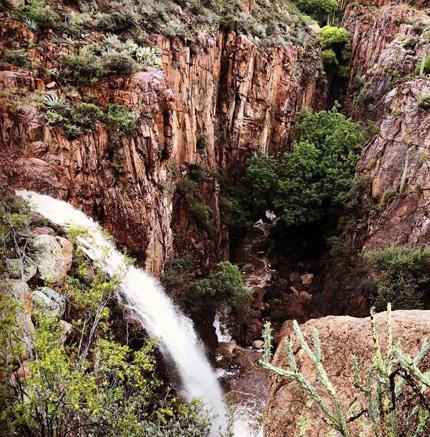
Consider the Sun Oven
I have been using my sun oven for close to 10 years. It only weighs 22 pounds, has a carrying handle attached to it and.… READ MORE

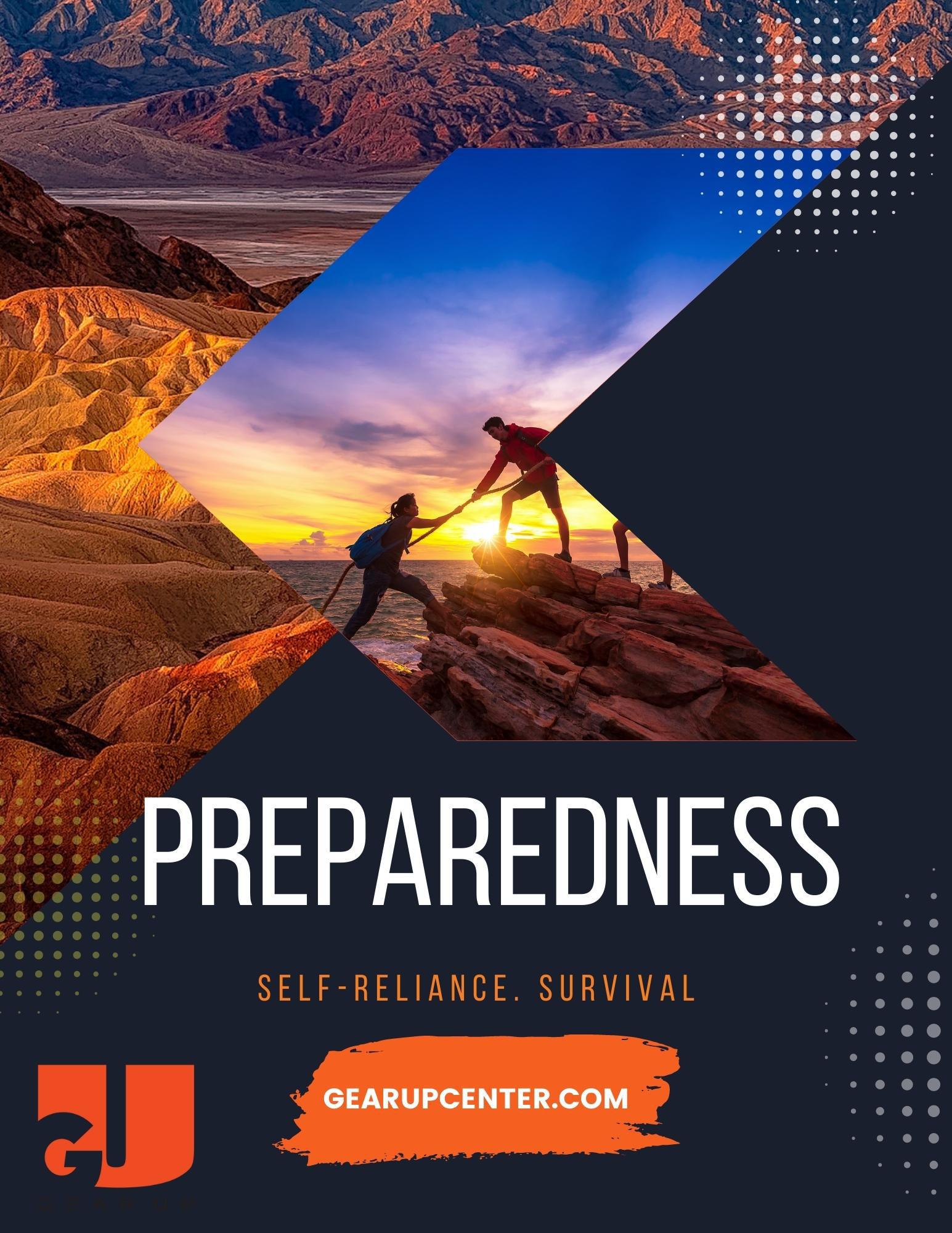








 author, the books,
author, the books,





 Photo by Polina Zimmerman
Photo by Polina Zimmerman


 Photo by Tntk
Photo by Tntk
 Photo by Bethany Bowater
Photo by Bethany Bowater









 Photo by Richellgen
Photo by Richellgen














 Photo by Schulzie
Photo by Schulzie

 Graphic for off grid rainwater harvest project.
Photo by Maridav
Graphic for off grid rainwater harvest project.
Photo by Maridav
 Graphic for off grid rainwater harvest project.
Photo by Yana Demyer Aerial view of cabin.
Graphic for off grid rainwater harvest project.
Photo by Yana Demyer Aerial view of cabin.


 Photo by Yana Demyer Rainwater capture 1 Our son, Spencer, enjoying his perch on the couch we floated it down to the cabin.
Photo by Timltv
Photo by Yana Demyer Rainwater capture 1 Our son, Spencer, enjoying his perch on the couch we floated it down to the cabin.
Photo by Timltv
 Photo by Prot Tachapanit
Photo by Prot Tachapanit
 Photo by David Pereiras
Photo by David Pereiras
 Photo
Photo





 Photo by Martin-dm
Photo by Martin-dm





 Photo by Stefan Stefancik
Photo by Stefan Stefancik












 Photo by Sanghwan Kim
Photo by Sanghwan Kim

 Photo by Sanghwan Kim
Photo by Sanghwan Kim




